Great Nebraska
Naturalists and ScientistsMarch 9, 1936
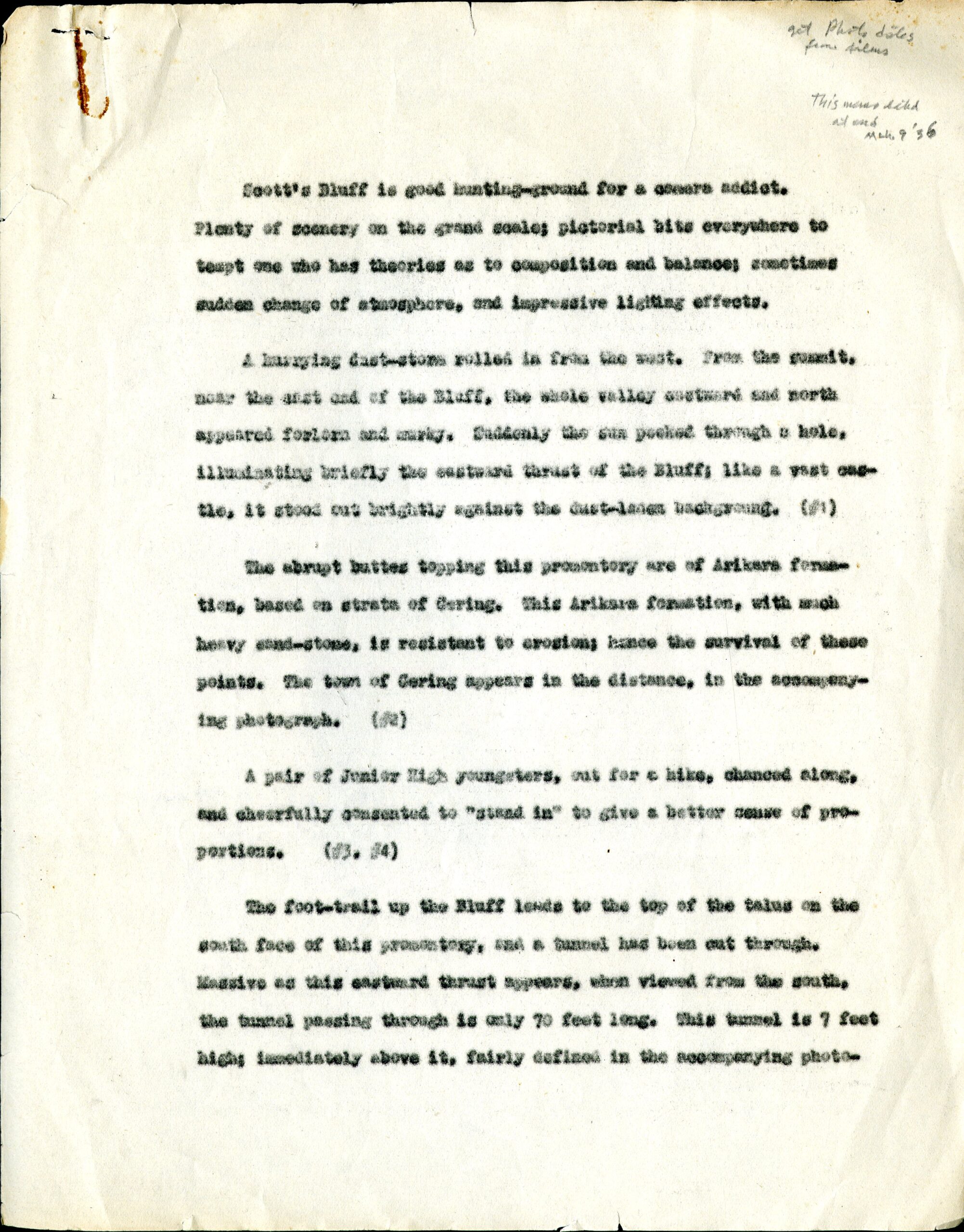
Scott’s Bluff is good hunting-ground for a [illegible] addict. Plenty of scenery on the grand scales; pictorial bits everywhere to tempt one who has theories as to composition and balance; sometimes sudden change of atmosphere, and impressive lighting effects.
A harrying dust-storm rolled in from the west. From the summit. Near the [illegible] and of the Bluff, the whole valley eastward and north appeared forlorn and [illegible]. Suddenly the sun peeked through a hole, illuminating briefly the eastward thrust of the Bluff; like a vast castle, it stood out brightly against the dust-[illegible] background (#1)
The abrupt butter topping this promontory are of Arikara formation, based on strata of Gering. This Arikara formation, with [illegible] heavy sand-stone, is resistant to erosion; hence the survival of these points. The town Gering appears in the distance, in the accompanying photograph. (#2)
A pair of Junior High youngsters, out for a hike, chanced along, and cheerfully consented to “stand in” to give a better sense of proportions. (#3, #4)
The foot-trail up to Bluff leads to the top of talus on the south face of the promontory, and a tunnel has been cut through. Massive as this eastward thrust appears, when viewed from the south, the tunnel passing through is only 70 feet long. This tunnel is 7 feet high immediately above it, fairly defined in the accompanying photo-
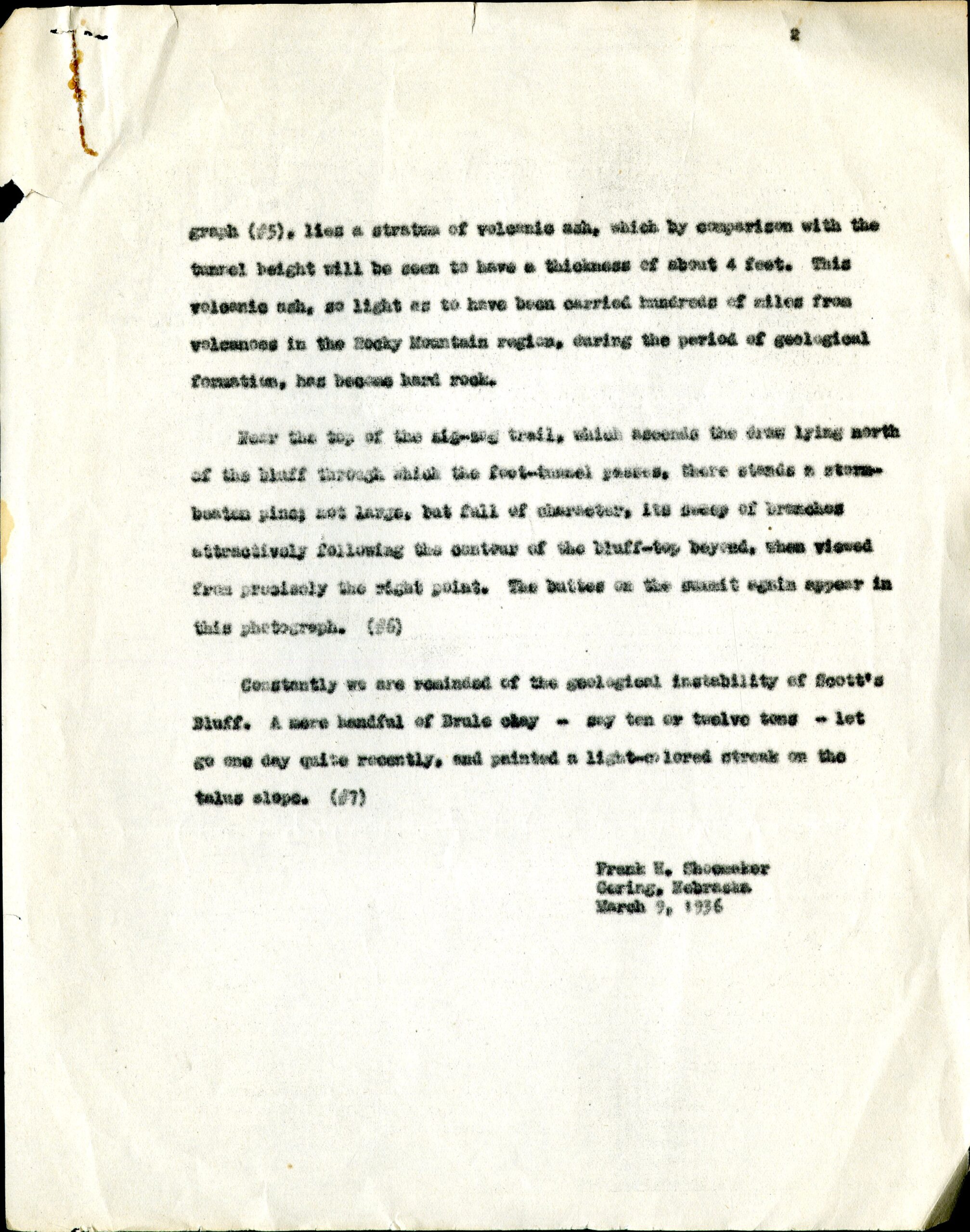
Graph (#5), lies a stratum of volcanic ash, which by comparison with the tunnel height will be seen to have a thickness of about 4 feet. This volcanic ash, so light as to have been carried hundreds of miles from volcanoes in the Rocky Mountain region, during the period of geological formation, has become hard rock.
Near the top of the zig-zag trail, which [illegible] the draw lying north of the bluff through which the foot-tunnel [illegible], there stands a storm-beaten pine, not large, but full of character, its [illegible] of branches attractively following the contour of the bluff-top beyond, when viewed from precisely the right point. The buttes on the summit again appear in this photograph. (#6)
Constantly we are reminded of the geological instability of Scott’s Bluff. A mere handful of Brule okay -say ten or twelve tons –let go one day quite recently, and painted a light-colored streak on the talus slope. (#7)
Frank H. Shoemaker Gering, Nebraska March 9, 1936
March 18, 1936
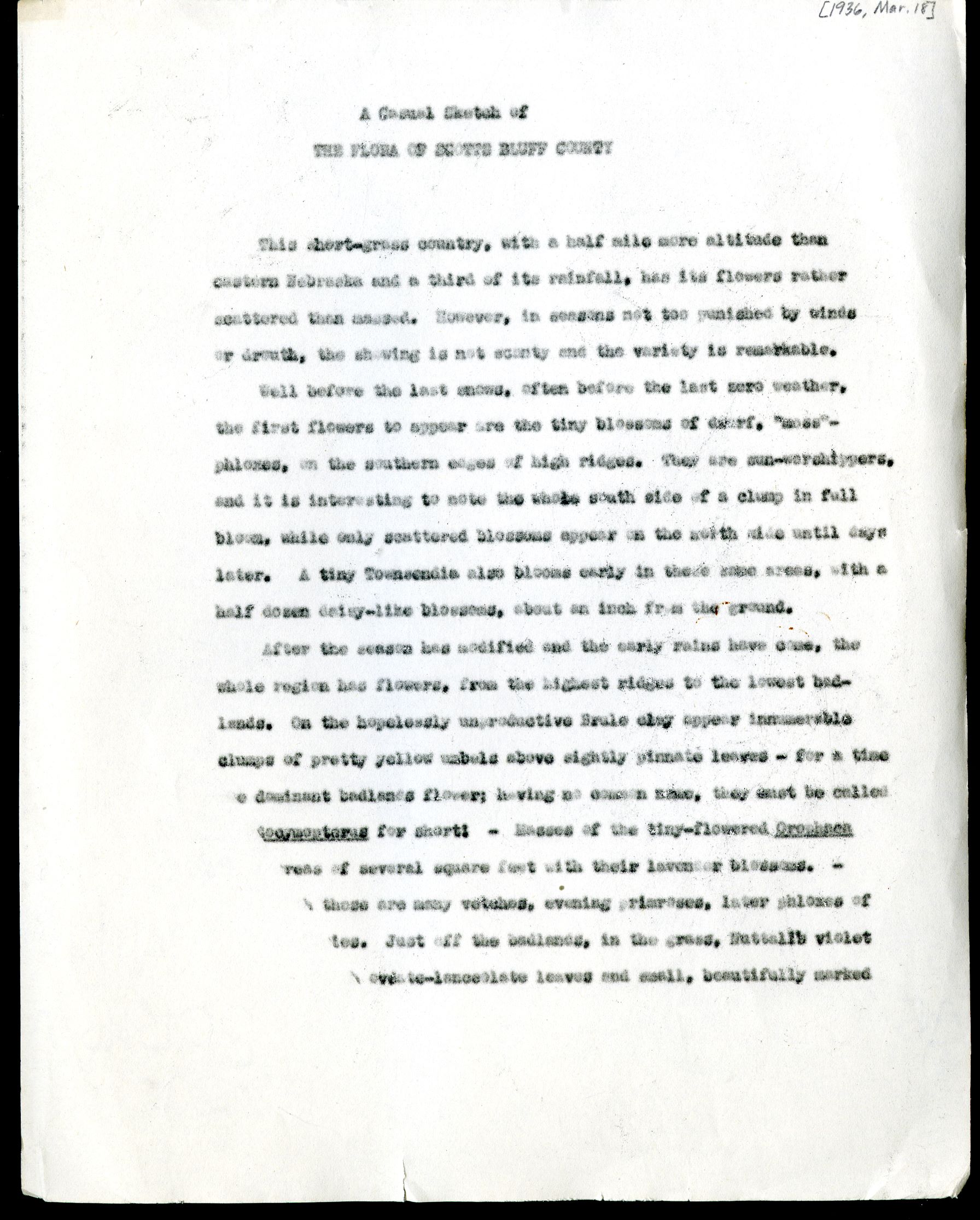
[1936, Mar. 18]
A Casual Sketch of THE FLORA OF SCOTTS BLUFF COUNTY
This short-grass country, with a half mile more altitude then eastern Nebraska and a third of its rainfall, has its flowers rather scattered than
Well before the last snows, often before the last zero weather, the first flowers to appear are the tiny blossoms of dwarf. “moss”-phloxes, on the southern edges of high ridges. They are sun-worshippers, and it is interesting to note the whole south side of a clump in full bloom, while only scattered blossoms appear on the north side until days later. A tiny Townsendia also blooms early in these same areas, with a half dozen daisy-like blossoms, about an inch form the ground.
After the season has modified and the early rains have come, the whole region has flowers, from the highest ridges to the lowest badlands. On the hopelessly unproductive Brule clay appear innumerable clumps of pretty yellow umbels above slightly pinnate leaves –for a time the dominant badlands flower; having common name, they must be called Pseadoeymopterus for short! –Along with these are many vetches, evening primreged, later phloxes of several species. Just off the badlands, in the grass, Nattalf’s violet is common, with ovate-leneeolate and small, beautifully marked yellow flowers.
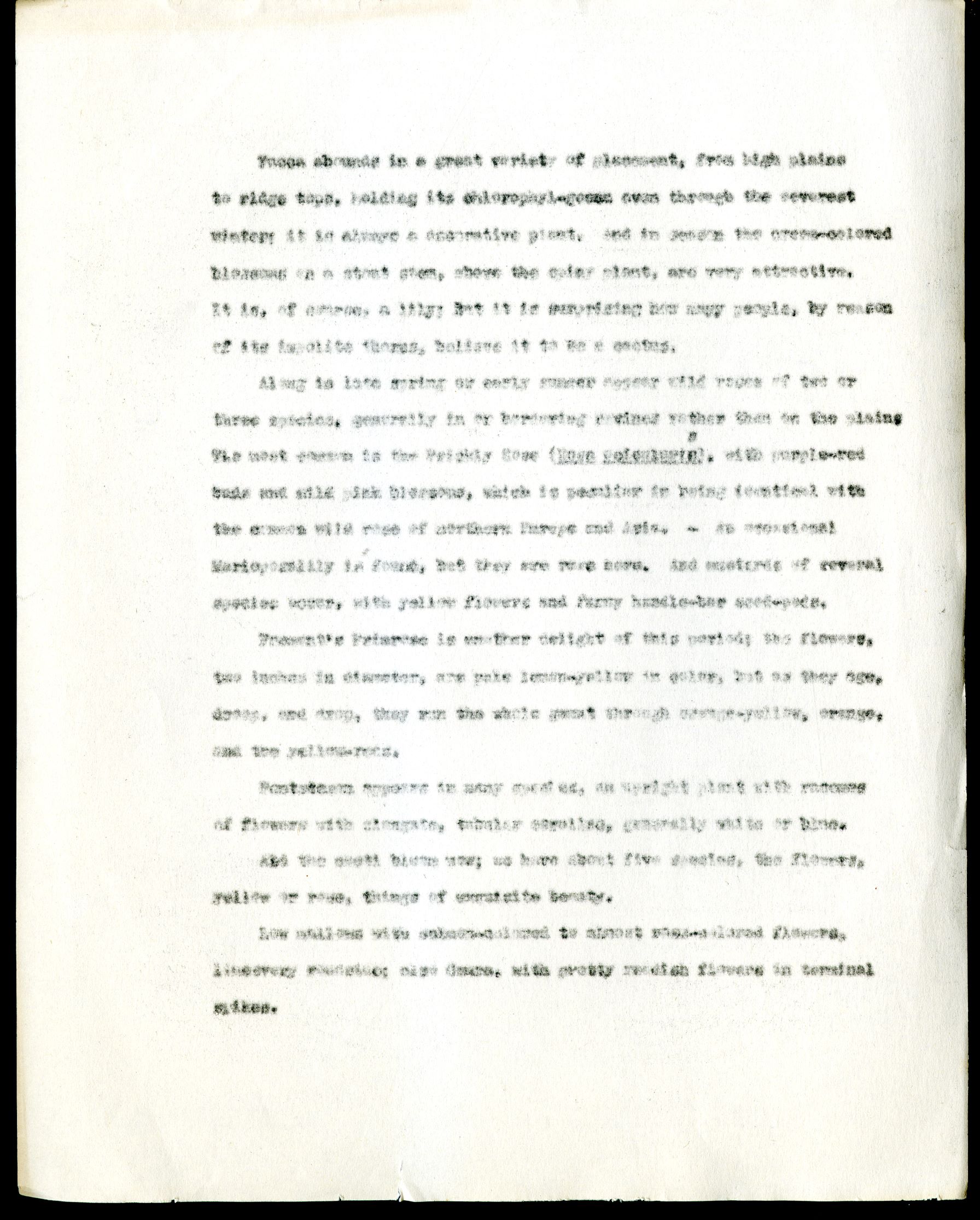
Yucca abounds in a great variety of placement, from high plains to ridge tops, holding its chlorophyll-green even through the severest winter; it is always a decorative plant. And in season the green-colored blossoms on a stout stem, above the spiny plant, are very attractive. It is, of course, a lily; But it is surprising how many people, by reason of its impolite thorns, believe it to be a cactus.
Along in the late spring or early summer appear wild roses of two or three species, generally in or bordering ravines rather than on the plains. The most common is the Prickly Rose (Rose seicularia), with purple-red buds and wild pink blossoms, which is peculiar in being identical with the common wild rose of northern Europe and Asia. –An occasional Marioposalily is found, but they are rare here. And mustards of several species occur, with yellow flowers and funny handle-bar seed-pods.
Fremont’s Primrose is another delight ofthis period; the flowers, two inches in diameter, are pale lemon-yellow in color, but as they age, droop, and drop, they run the whole garmit through orange-yellow, orange, and the yellow-reds.
Pentstemon appears in many species, an upright plant with raceaes of flowers with elongate, tubular corollno, generally white or blue.
And the cacti bloom now; we have about five species, the flowers, yellow or rose, things of exquisite beauty.
Low mallows with salmon-colored to almost rose-colored flowers, lineevery roseaiea; also Caura, with pretty reddish flowers in terminal spikes.

Cleome appears in bloom in the early autumn (our species is aerrulata); it is really one of the ornate and beautiful blossoms of this region. Masses fringe the rosesides, and the lavender-to-pink blossoms in loose racemoes are things of beauty; it is one of two local forms which should be utilised to the utmost in decorative planting. And it may be offered, as a sap to the economically-insistent, that turkeys simply love the seeds!
In the early autumn appear our only mass formations of flowers. Acres and acres of sunflowers (helianthus), of several species, most of them native, some achieving maturity and full bloom at a height of six inches! Perhaps the opinion is Oscar-Wildeish, but an area of sunflowers in full bloom, turning on their stalks to follow their god and sun, presents a certain aspect of beauty. And later, how the pheasants love these fields, for the fallen seeds! Some of the best pheasant-shooting, after one has studied the schedule of the birds, is in these sunflower patches.
And about now, Chrysethamnes comes into flower. It is a bushy thing, from two to seven feet high, and is of the same species as that of New Mexico, where it is called, most obscurely, “rabbit-brush.” It is a cousin of the golden-rod, and bears a multitude of golden blossoms, completely dominating and characterising its area and lasting in full beauty until killed by cold weather. – This, and Cleome, are the two native flowers most worthy of extenstive planting, in any program which looks toward beautification. As regards Chrysethsmus, the seeds, having
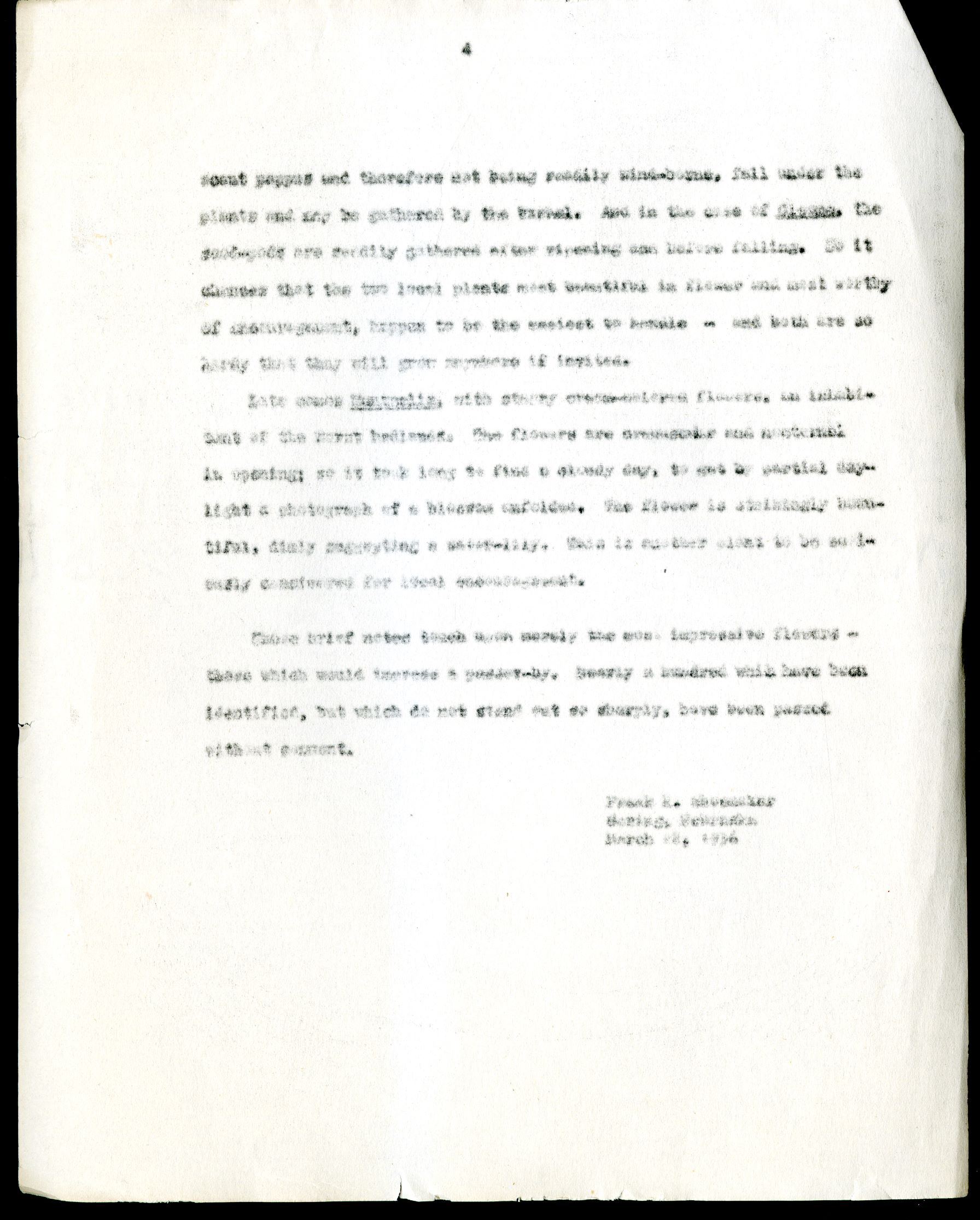
scent pappus and therefore not being readily wind-borne, fell under the plants and may be gathered by the bushel. And in the case of Cleome, the seed-pods are readily gathered after ripening and before falling. So it chances that the two local plants most beautiful in flower and most worthy of encouragement, happen to be the easiest to handle – and both are so hardy that they will grow anywhere if invited.
Late comes Mentselia, with sturry crese-colored flowers, an inhavitant of the worst badlands. The flowers are
These brief notes touch upon merely the most impressive flowers – these which would impress a passer-by. Nearly a hundred
Frank H. Shoemaker Gering, Nebraska March 18, 1936
April 4, 1936
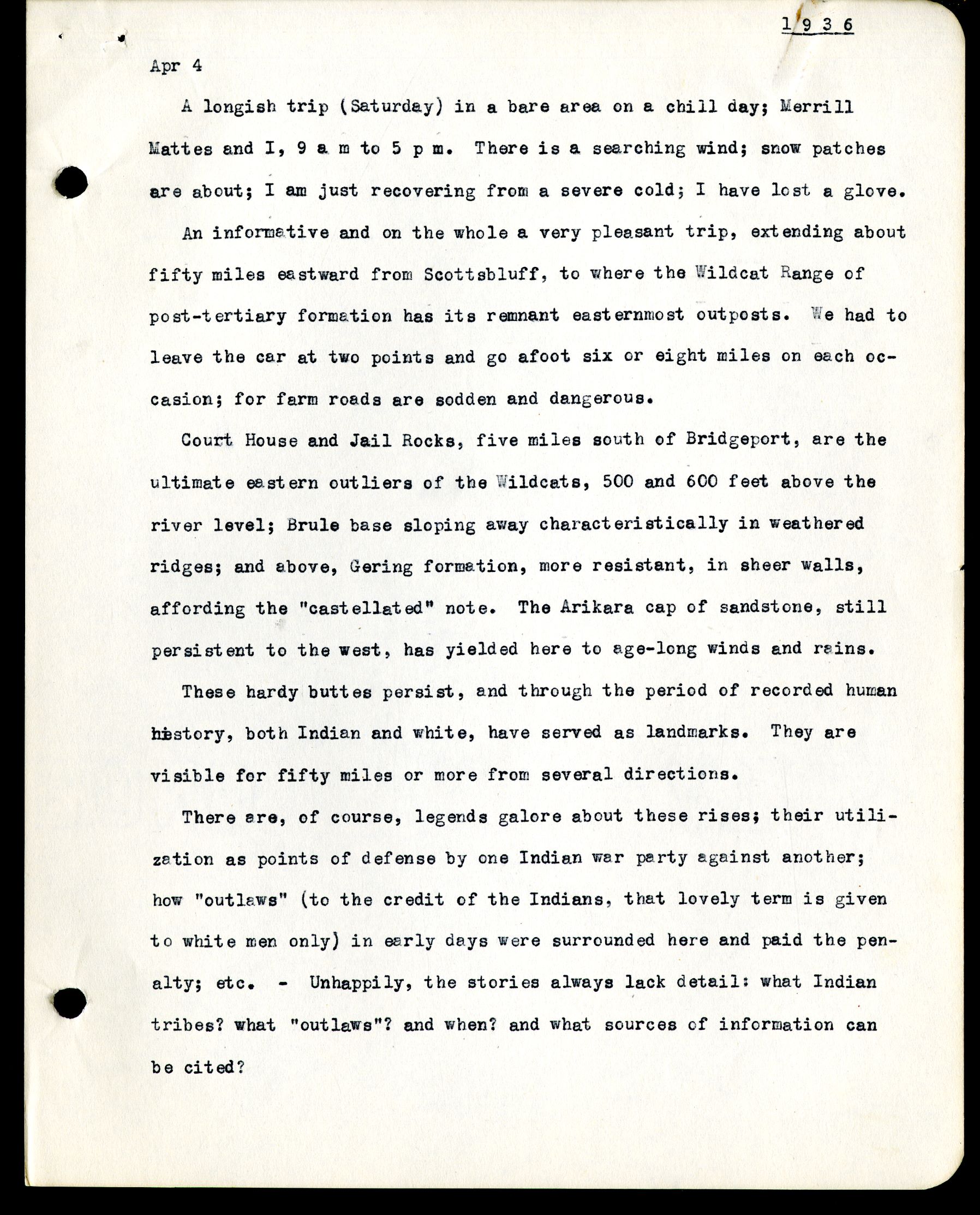
1936
Apr 4
A longish trip (Saturday) in a bare area on a chill day; Merrill Mattes and I, 9 a m to 5 p m. There is a searching wind; snow patches are about; I am just recovering from a severe cold; I have lost a glove.
An informative and on the whole a very pleasant trip, extending about fifty miles eastward from Scottsbluff, to where the Wildcat Range of post-tertiary formation has its remnant easternmost outposts. We had to leave the car at two points and go afoot six or eight miles on each occasion; for farm roads are sodden and dangerous.
Court House and Jail Rocks, five miles south of Bridgeport, are the ultimate eastern outliers of the Wildcats, 500 and 600 feet above the river level; Brule base sloping away characteristically in weathered ridges; and above, Gering formation, more resistant, in sheer walls, affording the “castellated” note. The Arikara cap of sandstone, still persistent to the west, has yielded here to age-long winds and rains.
These hardy buttes persist, and through the period of recorded human history, both Indian and white, have served as landmarks. They are visible for fifty miles or more from several directions.
There are, of course, legends galore about these rises; their utilization as points of defense by one Indian war party against another; how “outlaws” (to the credit of the Indians, that lovely term is given to white men only) in early days were surrounded here and paid the penalty; etc. – Unhappily, the stories always lack detail: what Indian tribes? What “outlaws”? and when? and what source s of information can be cited?
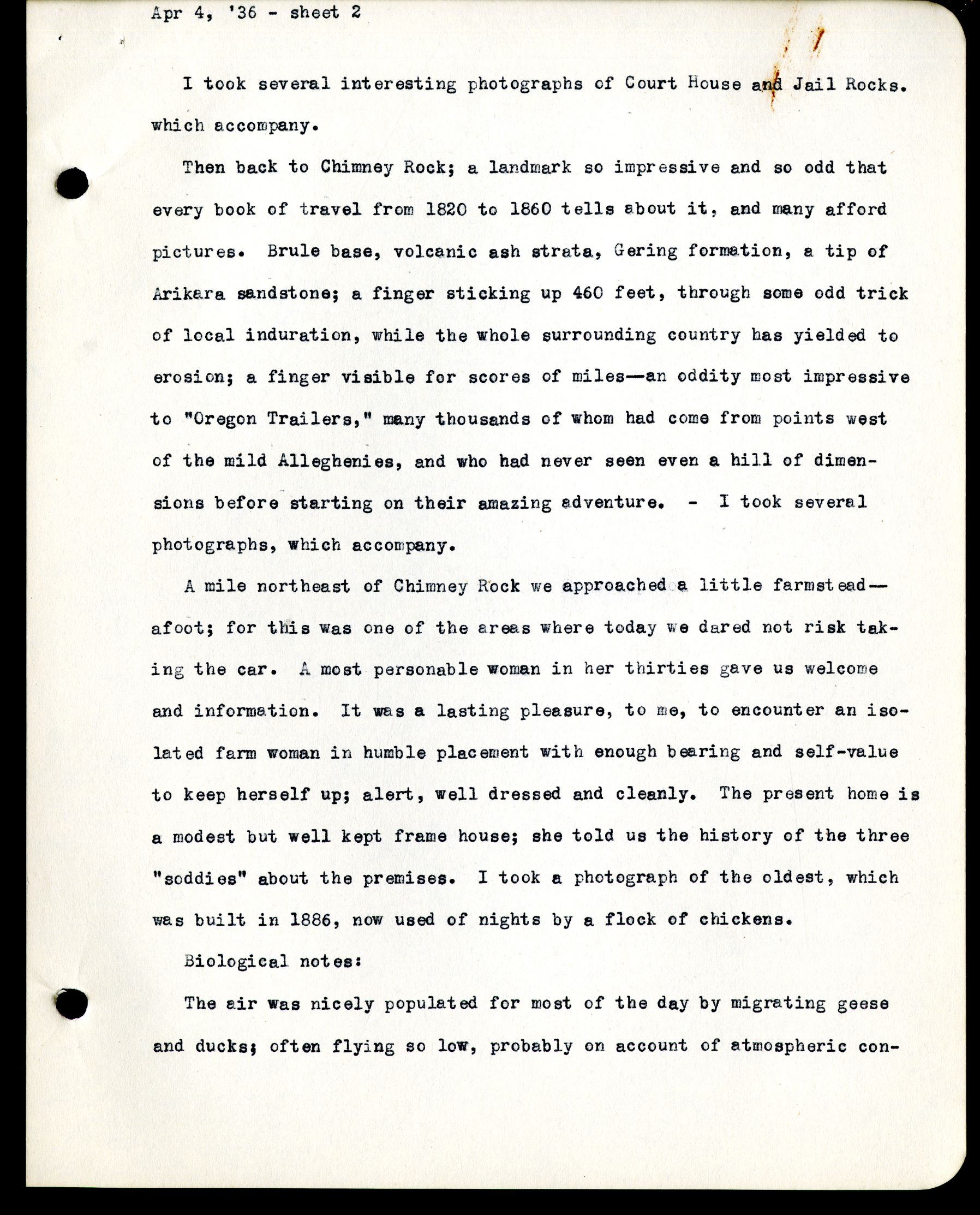
Apr 4, ’36 – sheet 2
I took several interesting photographs of Court House and Jail rocks. which accompany.
Then back to Chimney Rock; a landmark so impressive and so odd that every book of travel from 1820 to 1860 tells about it, and many afford pictures. Brule base, volcanic ash strata, Gering formation, a tip of Arikara sandstone; a finger sticking up 460 feet, through some odd trick of local induration, while the whole surrounding country has yielded to erosion; a finger visible for scores of miles-an oddity most impressive to “Oregon Trailers,” many thousands of whom had come from points west of the mild Alleghenies, and who had never seen even a hill of dimensions before starting on their amazing adventure. – I took several photographs, which accompany.
A mile northeast of Chimney Rock we approached a little farmstead – afoot; for this was one of the areas where today we dared not risk taking the car. A most personable woman in her thirties gave us welcome and information. It was a lasting pleasure, to me, to encounter an isolated farm woman in humble placement with enough bearing and self-value to keep herself up; alert, well dressed and cleanly. The present home is a modest but well kept frame house; she told us the history of the three “soddies” about the promises. I took a photograph of the oldest, which was built in 1886, now used of nights by a flock of chickens.
Biological notes: The air was nicely populated for most of the day by migrating geese and ducks; often flying so low, probably on account of atmospheric con-
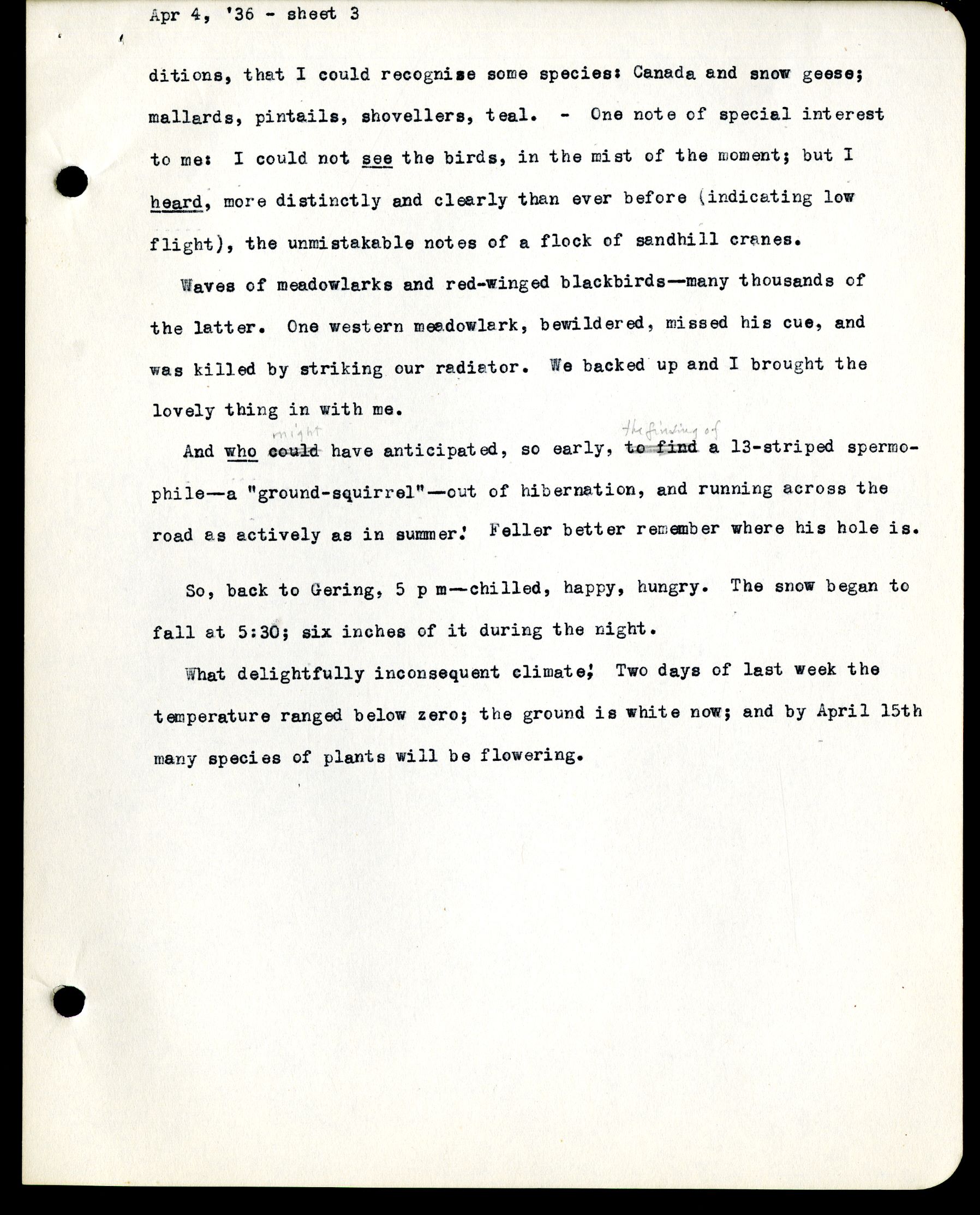
Apr 4, ’36 – sheet 3
ditions, that I could recognise some species: Canada and snow geese; mallards, pintails, shovellers, teal. – One note of special interest to me: I could not see the birds, in the mist of the moment; but I heard, more distinctly and clearly than ever before (indicating low flight), the unmistakable notes of a flock of sandhill cranes.
Waves of meadowlarks and red-winged blackbirds – many thousands of the latter. One western meadowlark, bewildered, missed his cue, and was killed by striking our radiator. We backed up and I brought the lovely thing in with me.
And who could might have anticipated, so early, to find the finding of a 13-striped spermophile – a “ground-squirrel” – out of hibernation, and running across the road as actively as in summer! Feller better remember where his hole is.
So, back to Gering, 5 p m – chilled, happy, hungry. The snow began to fall at 5:30; six inches of it during the night.
What delightfully inconsequent climate! Two days of last week the temperature ranged below zero; the ground is white now; and by April 15th many species of plants will be flowering.
April 8 to June 18, 1936
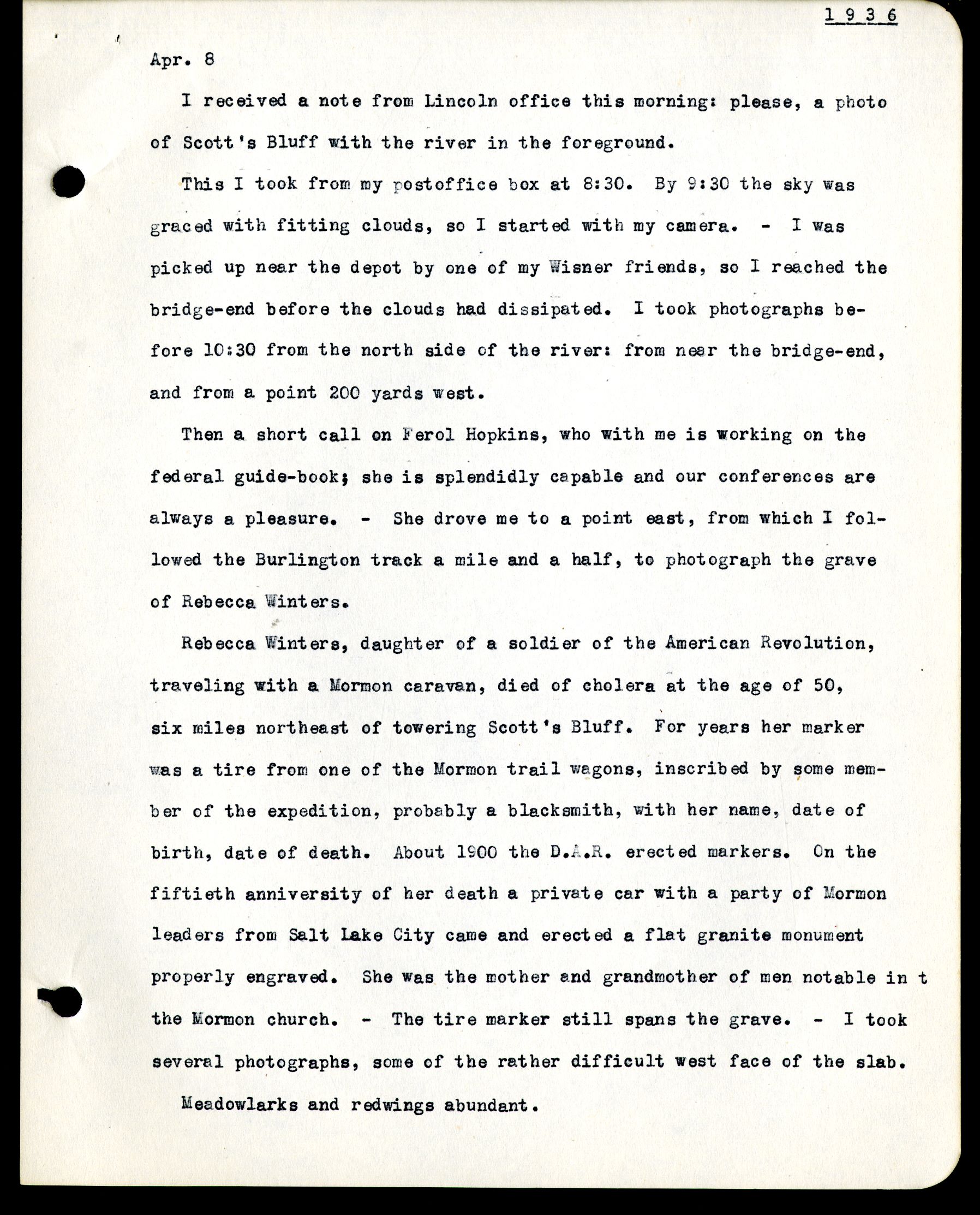
1936
Apr. 8
I received a note from Lincoln office this morning: please, a photo of Scott’s Bluff with the river in the foreground.
This I took from my postoffice box at 8:30. By 9:30 the sky was graced with fitting clouds, so I started with my camera. – I was picked up near the depot by one of my Wisner friends, so I reached the bridge-end before the clouds had dissipated. I took photographs before 10:30 from the north side of the river: from near the bridge-end, and from a point 200 yards west.
Then a short call on Ferol Hopkins, who with me is working on the federal guide-book; she is splendidly capable and our conferences are always a pleasure. – She drove me to a point east, from which I followed the Burlington track a mile and a half, to photograph the grave of Rebecca Winters.
Rebecca Winters, daughter of a soldier of the American Revolution, traveling with a Mormon caravan, died of cholera at the age of 50, six miles northeast of towering Scott’s Bluff. For years her marker was a tire from one of the Mormon trail wagons, inscribed by some member of the expedition, probably a blacksmith, with her name, date of birth, date of death. About 1900 the D.A.R. erected markers. On the fiftieth anniversity of her death a private car with a party of Mormon leaders from Salt Lake City came and erected a flat granite monument properly engraved. She was the mother and grandmother of men notable in it the Mormon church. – The tire marker still spans the grave. – I took several photographs, some of the rather difficult west face of the slab.
Meadowlarks and redwings abundant.
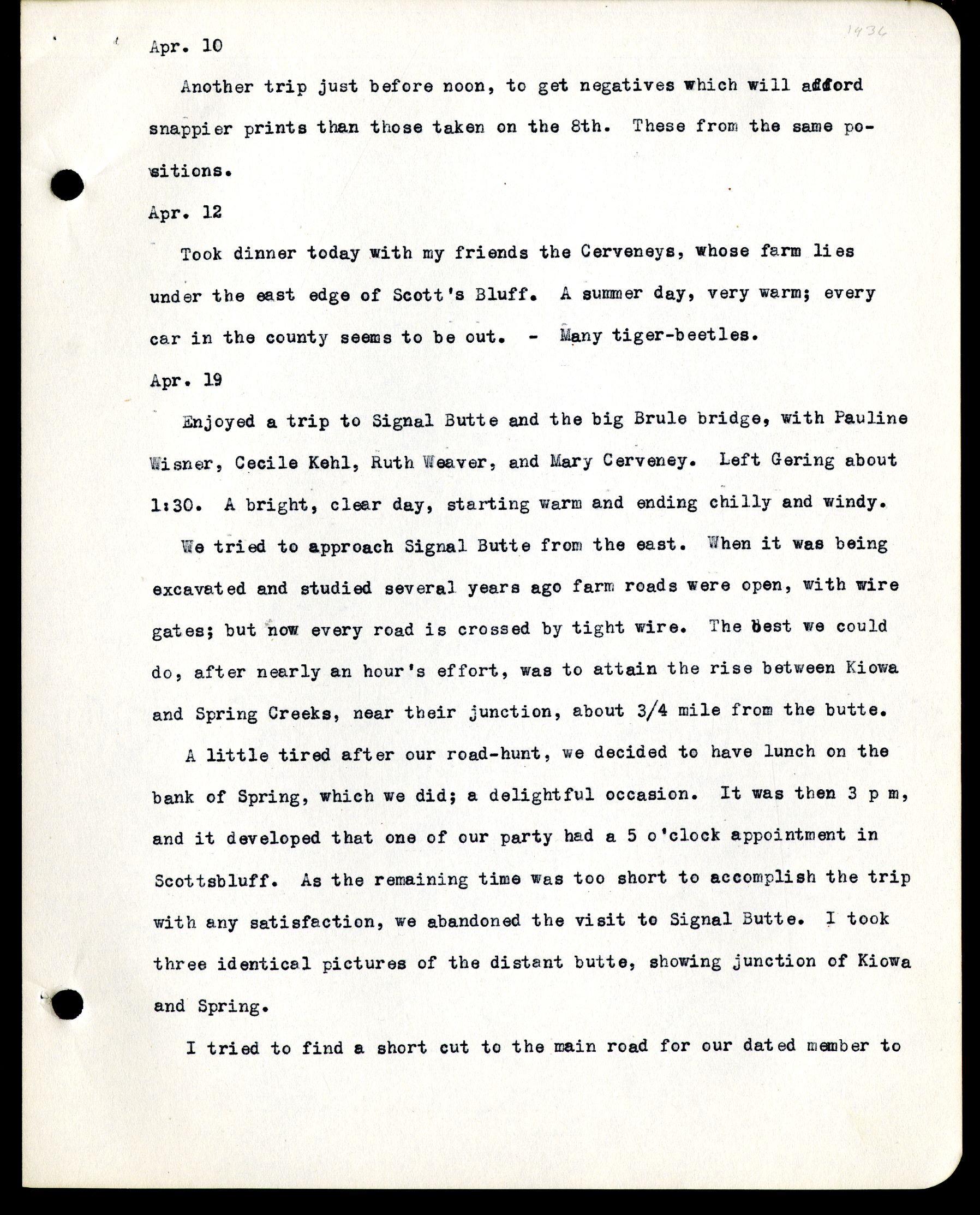
Apr. 10 Another trip just before noon, to get negatives which will afford snappier prints than those taken on the 8th. These from the same positions.
Apr. 12 Took dinner today with my friends the Cerveneys, whose farm lies under the east edge of Scott’s Bluff. A summer day, very warm; every car in the county seems to be out. – Many tiger-beetles.
Apr. 19 Enjoyed a trip to Signal Butte and the big Brule bridge, with Pauline Wisner, Cecile Kehl, Ruth Weaver, and Mary Cerveney. Left Gering about 1:30. A bring, clear day, starting warm and ending chilly and windy.
We tried to approach Signal Butte from the east. When it was being excavated and studied several years ago farm roads were open, with wire gates; but now every road is crossed by tight wire. The best we could do, after nearly an hour’s effort, was to attain the rise between Kiowa and Spring Creeks, near their junction, about ¾ mile from the butte.
A little tired after our road-hunt, we decided to have lunch on the bank of Spring, which we did; a delightful occasion. It was then 3 p m, and it developed that one of our party had a 5 o’clock appointment in Scottsbluff. As the remaining time was too short to accomplish the trip with any satisfaction, we abandoned the visit to Signal Butte. I took three identical pictures of the distant butte, showing junction of Kiowa and Spring.
I tried to find a short cut to the main road for our dated member to
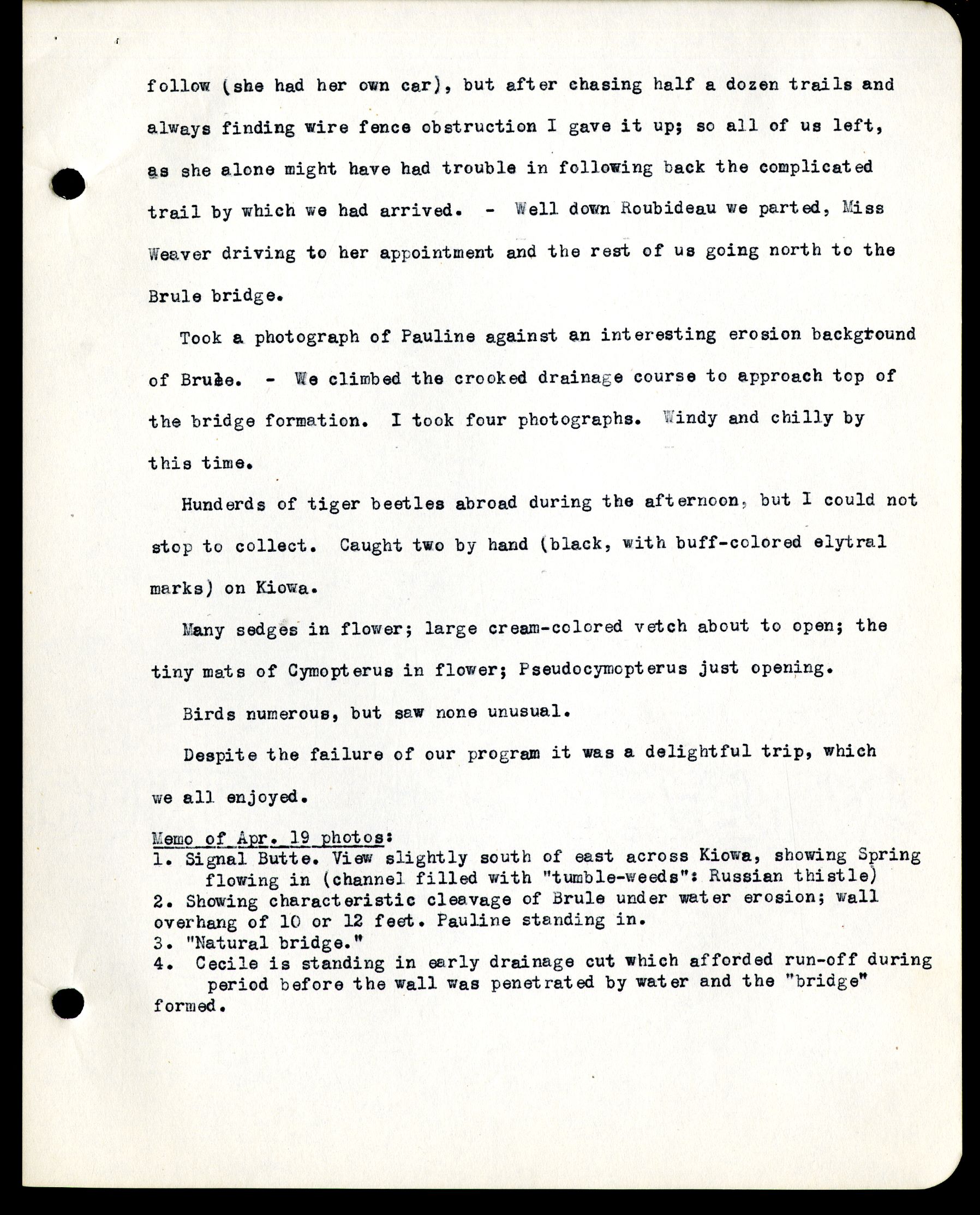
follow (she had her own car), but after chasing half a dozen trails and always finding wire fence obstruction I gave it up; so all of us left, as she alone might have had trouble in following back the complicated trail by which we had arrived. – Well down Roubideau we parted, Miss Weaver driving to her appointment and the rest of us going north to the Brule bridge.
Took a photograph of Pauline against an interesting erosion background of Brule. – We climbed the crooked drainage course to approach top of the bridge formation. I took four photographs. Windy and chilly by this time.
Hundreds of tiger beetles abroad during the afternoon, but I could not stop to collect. Caught two by hand (black, with buff-colored elytral marks) on Kiowa.
Many sedges in flower; large cream-colored vetch about to open; the tiny mats of cymopterus in flower; Pseudocympoterus just opening.
Birds numerous, but saw none unusual.
Despite the failure of our program it was a delightful trip, which we all enjoyed.
Memo of Apr. 19 photos: 1. Signal Butte. View slightly south of east across Kiowa, showing Spring flowing in (channel filled with “tumble-weeds”: Russian thistle) 2.Showing characteristic cleavage of Brule under water erosion; wall overhang of 10 or 12 feet. Pauline standing in. 3. “Natural bridge.” 4. Cecile is standing in early drainage cut which afforded run-off during period before the wall was penetrated by water and the “bridge” formed.
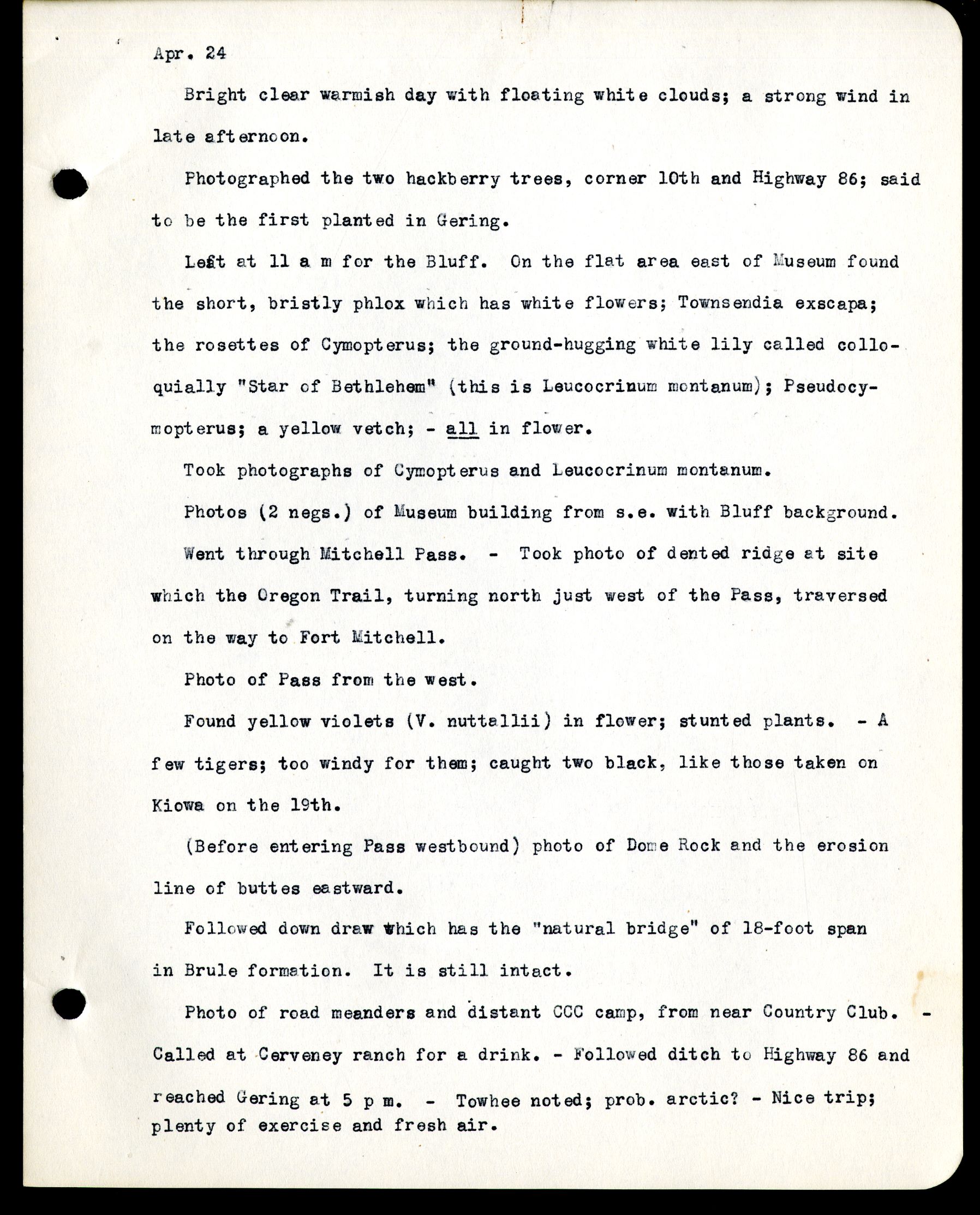
Apr. 24 Bright clear warmish day with floating white clouds; a strong wind in late afternoon.
Photographed the two hackberry trees, corner 10th and Highway 86; said to be the first planted in Gering.
Left at 11 a m for the Bluff. On the flat area east of museum found the short, bristly phlox which has white flowers; Townsendia exscapa; the rosettes of Cymopterus; the ground-hugging white lily called colloquially “Star of Bethlehem” (this is Leucocrinum montanum); Pseudocymopterus; a yellow vetch; – all in flower.
Took photogrpahs of Cymopterus and Leucocrinum montenum.
Photos (2 negs.) of Museum building form s.e. with Bluff background.
Went through Mitchell Pass. – Took photo of dented ridge at site which the Oregon Trail, turning north just west of the Pass, traversed on the way to Fort Mitchell.
Photo of Pass from the west.
Found yellow violets (V. nuttallii) in flower; stunted plants. – A few tigers; too windy for them; caught two black, like those taken on Kiowa on the 19th.
(Before entering Pass westbound) photoof Dome Rock and the erosion line of buttes eastward.
Followed down draw which has the “natural bridge” of 18-foot span in Brule formation. It is still intact.
Photo of road meanders and distant CCC camp, from near Country Club. – Called at Cerveney ranch for a drink. – Followed ditch to Highway 86 and reached Gering at 5 p m. – Towhee noted; prob. arctic? – Nice trip; plenty of exercise and fresh air.
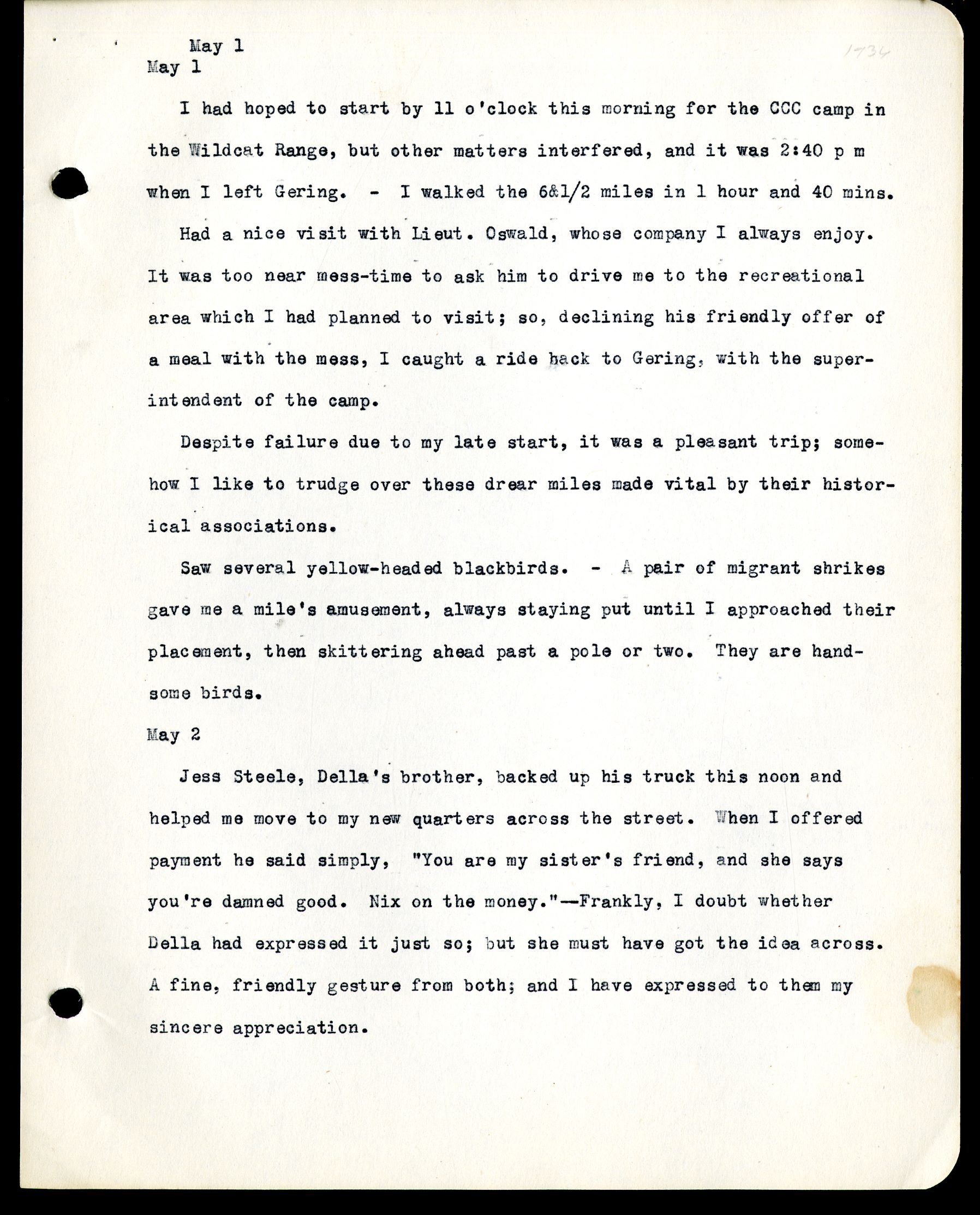
May 1 May 1 I had hoped to start by 11 o’clock this morning for the CCC camp in the Wildcat Range, but other matters interfered, and it was 2:40 p m when I left Gering. – I walked the 6&½ miles in 1 hour and 40 mins.
Had a nice visit with Lieut. Oswald, whose company I always enjoy. It was too near mess-time to ask him to drive me to the recreational area which I had planned to visit; so, declining his friendly offer of a meal with the mess, I caught a ride back to Gering, with the superintendent of the camp.
Despite failure due to my late start, it was a pleasant trip; somehow I like to trudge over these drear miles made vital by their historical associations.
Saw several yellow-headed blackbirds. – A pair of migrant shrikes gave me a mile’s amusement, always staying put until I approached their placement, then skittering ahead past a pole or two. They are handsome birds.
May 2 Jess Steele, Della’s brother, backed up his truck this noon and helped me move to my new quarters across the street. When I offered payment he said simply, “You are my sister’s friend, and she says you’re damned good. Nix on the money.” – Frankly, I doubt whether Della had expressed it just so; but she must have got the idea across. A fine, friendly gesture from both; and I have expressed to them my sincere appreciation.

Helen Blish, one of my most admired friends, is in town. She had been for months in the Santa Fe area, seeking health and strength; when the death of her father some weeks ago necessitated an eastern trip. She will be in Gering for about three days, and tomorrow she and her friends will call for me, for an outing west of Mitchell Pass.
May 3 The party called for me at 11:30: Helen; Della Steele, her friend and mine; Doris Evans, whom is Helen is visiting; and Doris’ mother. – The day was bright, clear, and warm, with fleecy clouds and a pleasant breeze.
We drove through Mitchell Pass and went 1&½ miles southwest to the newly established picnic grounds on the Monument area; a fine placement, now fitting with tables and grills, and some trails laid out. Already it is recognized; there were over twenty cars on the parking area, with about a hundred people on the grounds. We selected a table comfortably shaded by a clump of cedars.
We all had a gratifying visit over the lunch period; then while Mrs. Evans rested in the shade we went for a stroll. We found in a flower: three kinds of phlox; three kinds of Astragalus; Nuttall’s violet; Townsendia exscapa; Leucocrinum montanum. – Sought in vain for a tiger-beetle to show them; not one! – Took several photographs. – It was a lazy, happy afternoon.
Della and Doris are splendid girls, and Mrs. Evans a lovable woman. Our association was a real delight to me, longing for just such companionship.

Helen is her usual charming self; too frail to leave me quite happy, but as always cheerful, enthusiastic, optimistic; a rare girl, whom I hold in most affectionate regard. We have exchange letters frequently, but aside from a few moments in Lincoln in 1932 I have not seen her since our delightful six weeks together, along with Ruth Moore, as quests of Dr. H.B. Alexander and Mrs. Alexander, in Santa Fe in 1927 – when all of us visited the many neighboring pueblos with such interest and pleasure. – She had been teaching in a Detroit high school for some years; this year she has free, for recuperation; and now she has lost her father – her mother died some years ago. A brave, lovable girl. – Doris is one of her intimate friends; to which fact I owe the delight of meeting Helen again. – I am trying hopefully to interest her in another visit, during which we might explore archeological and historical points of interest all the way from Court House Rock to the Spanish Diggings in Wyoming – a project upon which our correspondence frequently has touched.
Della took a photograph of Helen and myself; and as she was about to make the exposure I saw that Helen was looking at the camera; so I said sharply, “Helen, don’t look at the camera; look at me!” She turned, with a most adorable grin. Result, Me with an apologetic simper, and a good view of Helen’s left ear! I had visualized her in profile!
This day will live long in my thoughts.
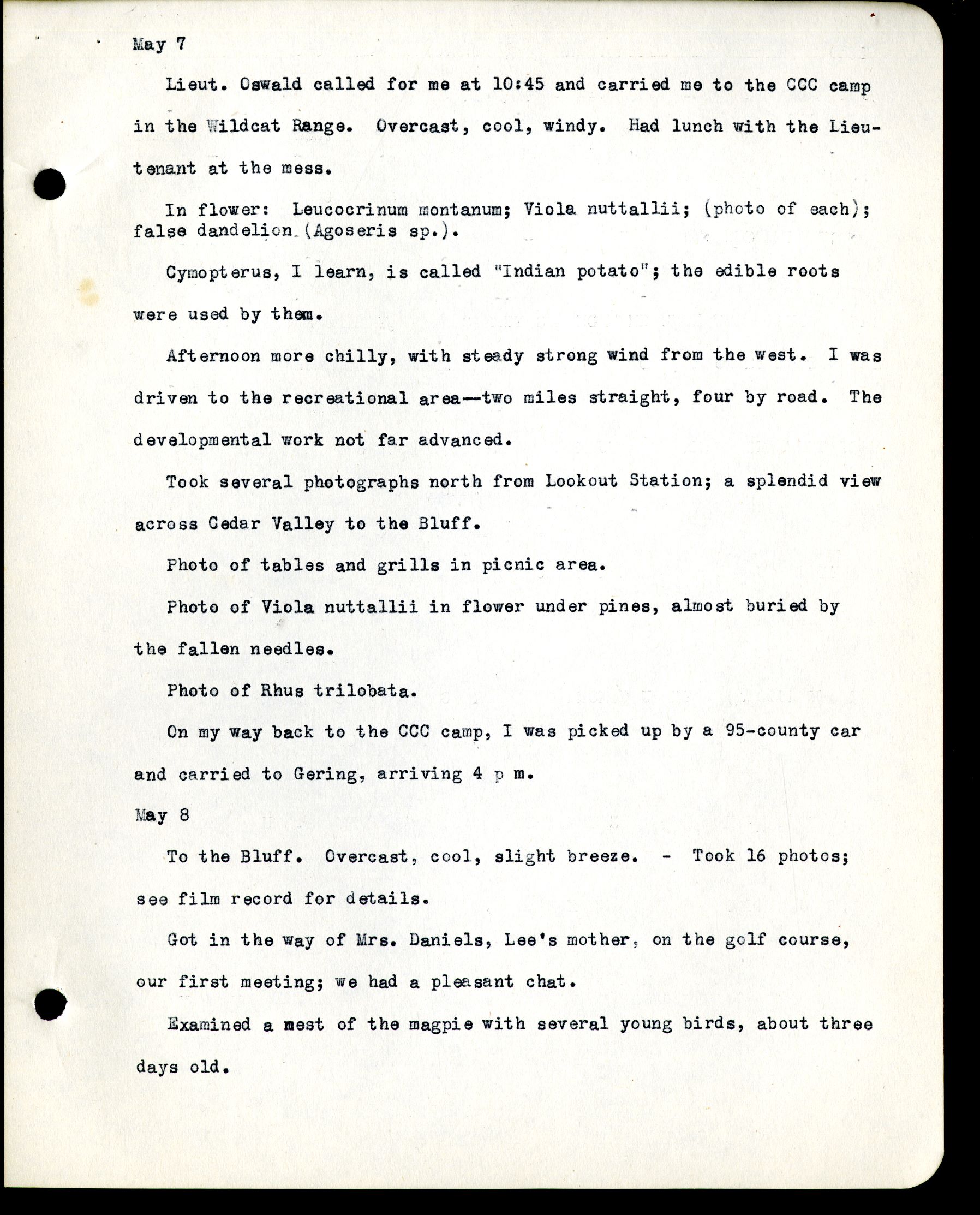
May 7 Lieut. Oswald called for me at 10:45 and carried me to the CCC camp in the Wildcat Range. Overcast, cool, windy. Had lunch with the Lieutenant at the mess.
In flower: Leucocrinum montanum; Viola nuttallii; (photo of each); false dandelion (Aposeris sp.).
Cymopterus, I learn, is called “Indian potato”; the edible roots were used by them.
Afternoon more chilly, with steady strong wind from the west. I was driven to the recreational area – two miles straight, four by road. The developmental work not far advanced.
Took several photogaphs north from Lookout Station; a splendid view across Cedar Valley to the Bluff.
Photo of tables and grills in picnic area.
Photo of Viola nuttallii in flower under pines, almost buried by the fallen needles.
Photo of Rhus triblobata.
On my way back to the CCC camp, I was picked up by a 95-county car and carried to Gering, arriving 4 p m.
May 8 To the Bluff. Overcast, cool, slight breeze. – Took 16 photos; see film record for details.
Got in the way of Mrs. Daniels, Lee’s mother, on the golf course, our first meeting; we had a pleasant chat.
Examined a nest of the magpie with several young birds, about three days old.
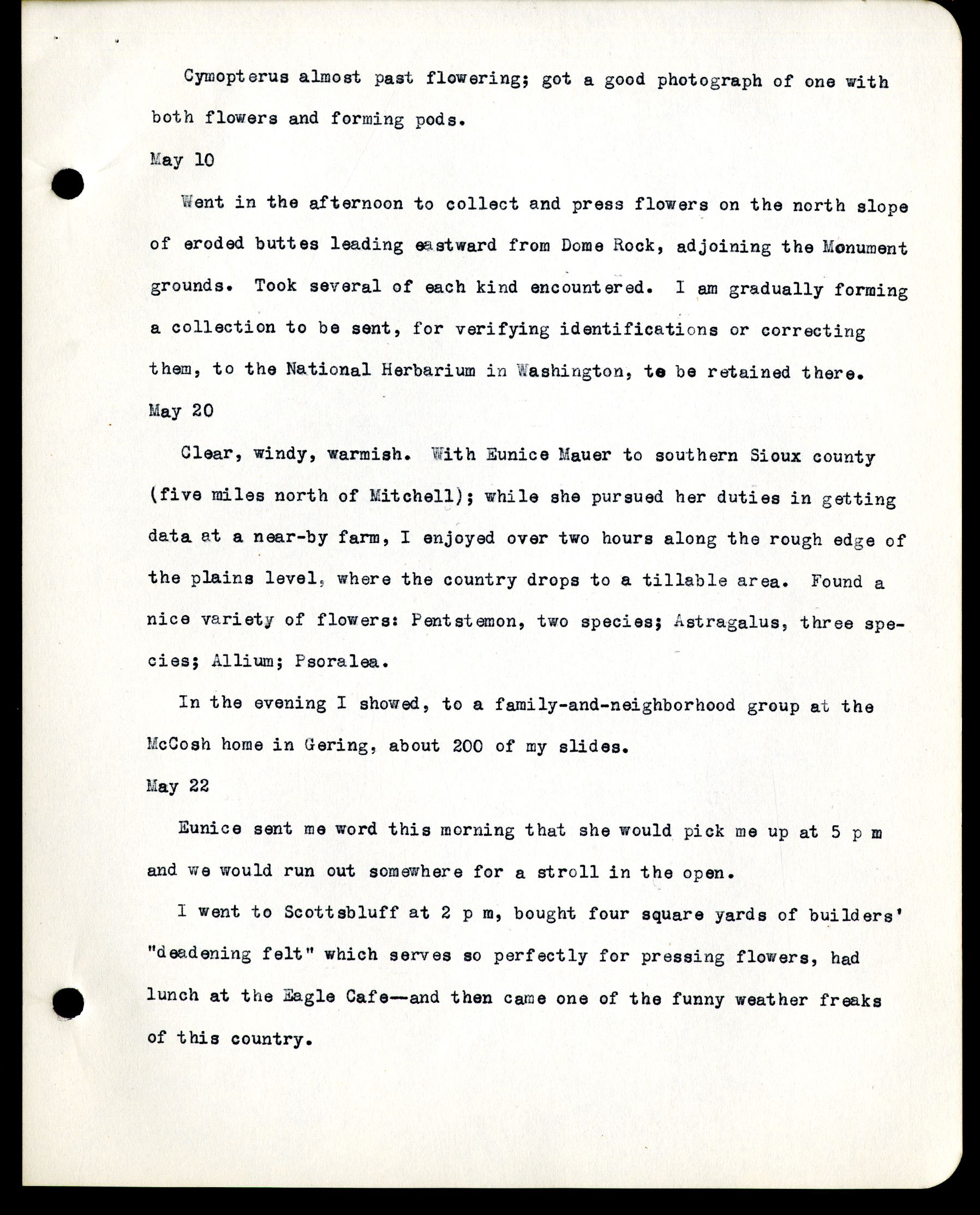
Cymopterus almost past flowering; got a good photograph of one with both flowers and forming pods.
May 10 Went in the afternoon to collect and press flowers on the north slope of eroded buttes leading eastward from Dome Rock, adjoining the Monument grounds. Took several of each kind encountered. I am gradually forming a collection to be sent, for verifying identifications or correcting them, to the National Herbarium in Washington, to be retained there.
May 20 Clear, windy, warmish. With Eunice Mauer to southern Sioux county (five miles north of Mitchell); while she pursued her duties in getting data at a near-by farm, I enjoyed over two hours along the rough edge of the plains level, where the country drops to a tillable area. Found a nice variety of flowers: Pentstemon, two species; Astragalus, three species; Allium; Psoralea.
In the evening I showed, to a family-and-neighborhood group at the McCosh home in Gering, about 200 of my slides.
May 22 Eunice sent me word this morning that she would pick me up at 5 p m and we would run out somewhere for a stroll in the open.
I went to Scottsbluff at 2 p m, bought four square yards of builders’ “deadening felt” which serves so perfectly for pressing flowers, had lunch at the Eagle Café – and then came one of the funny weather freaks of this country.

The sun faded out in a minute, at about 3 p m; a violent northwest wind ensued immediately, and clouds of dust obscured everything. I rushed to the near-by Star-Herald office; form its front windows the store-fronts across the street were invisible; care caught out moved at a safety-seeking “speed” of about eight miles an hour, with all lights on; the air was a murky maelstrom. Against the faintly lighted lower west, under a vast and rapidly moving dust-cloud, the tops of buildings across the street were barely visible. How I wished for my camera!
Dust; then thunder and lightning; then rain; then a spat of hail, but with small stones. And within a total of twenty minutes the spate had sent itself; the sun came out, the wind ceased, and everything was lovely. – what a funny, funny country! And how I love it!
At 3 p m nothing could have been more remote than the possibility of keeping to our 5 p m schedule. But peace and quiet ensued; and the dry roads suck up moisture like a sponge. So at 5 p m behold our party assembled and undismayed: Eunice, her brother, Bertha Somebody from the office where Eunice works, and myself. Came the problem: Where? I thought of the Brule “natural bridge” six miles west, ten or more by roads; I made the suggestion, and the idea was favored.
We followed the course known to me, parked the car as usual at the ultimate point it could reach, avoided the first canyon, cut across the buffalo-grama grass to the second canyon, and followed its course to the “bridge.” Some of my companions, upon hearing my tall tales about
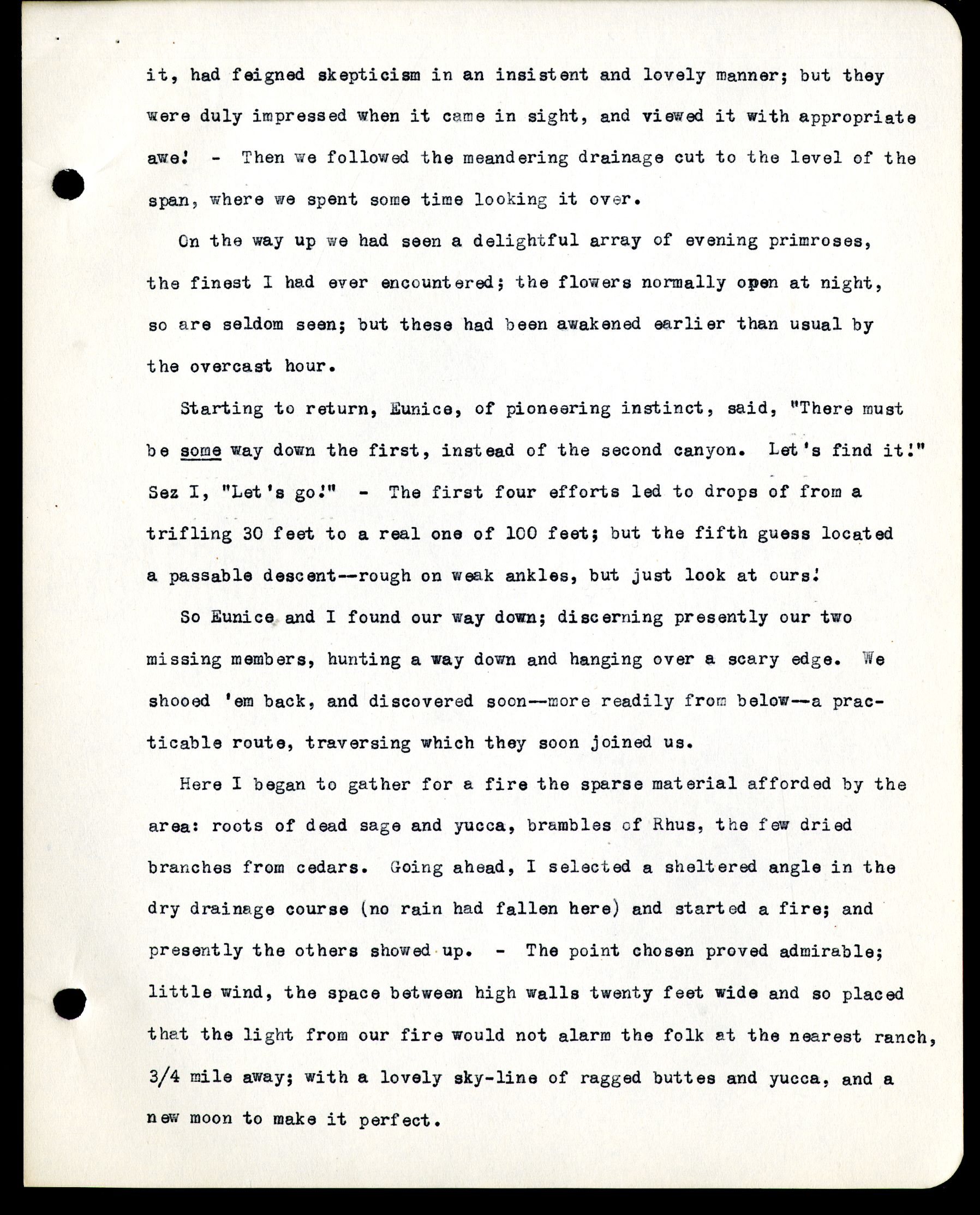
it, had feigned skepticism in an insistent and lovely manner; but they were duly impressed when it came in sight, and viewed it with appropriate awe! – Then we followed the meandering drainage out to the level of the span, where we spent some time looking it over.
On the way up we had seen a delightful array of evening primroses, the finest I had ever encountered; the flowers normally open at night, so are seldom seen; but these had been awakened earlier than usual by the overcast hour.
Starting to return, Eunice, of pioneering instinct, said, “There must be some way down the first, instead of the second canyon. Let’s find it!” Sez I, “Let’s go!” – The first four efforts led to drops of from a trifling 30 feet to a real one of 100 feet; but the fifth guess located a passable descent – rough on weak ankles, but just look at ours!
So Eunice and I found our way down; discerning presently our two missing members, hunting a way down and hanging over a scary edge. We shooed ‘em back, and discovered soon – more readily from below – a practicable route, traversing which they soon joined us.
Here I began to gather for a fire the sparse material afforded by the area: roots of dead and sage and yucca, brambles of Rhus, the few dried branches from cedars. Going ahead, I selected a sheltered angle in the dry drainage course (no rain had fallen here) and started a fire; and presently the others showed up. – The point chosen proved admirable; little wind, the space between high walls twenty feet wide and so placed that the light from our fire would not alarm the folk at the nearest ranch, ¾ mile away; with a lovely sky-line of ragged buttes and yucca, and a new moon to make it perfect.
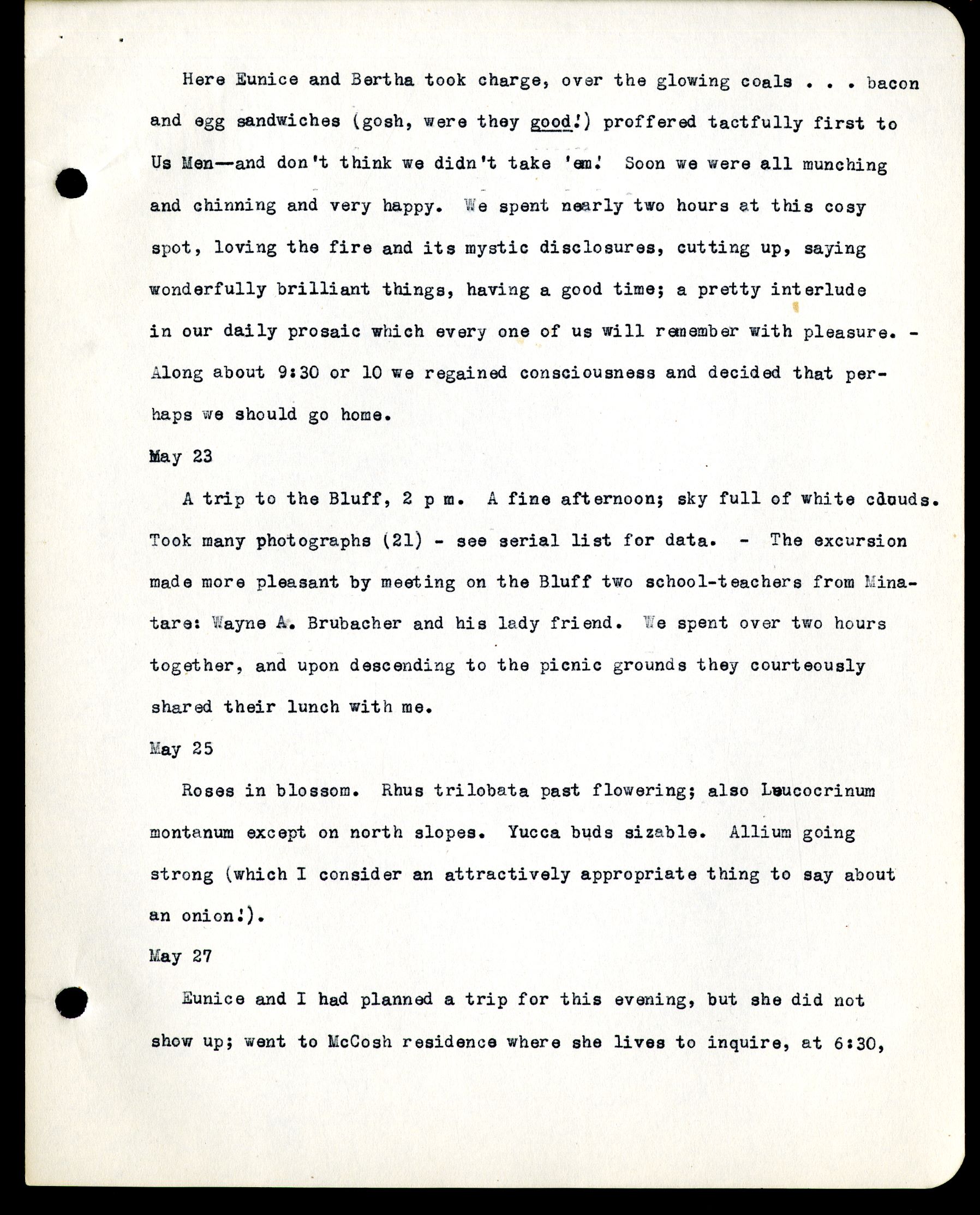
Here Eunice and Bertha took charge, over the glowing coals…bacon and egg sandwiches (gosh, were they good!) proffered tactfully first to Us Men – and don’t think we didn’t take ‘em! Soon we were all munching and chinning and very happy. We spent nearly two hours at this cosy spot, loving the fire and its mystic disclosures, cutting up, saying wonderfully brilliant things, having a good time; a pretty interlude in our daily prosaic which every one of us will remember with pleasure. – Along about 9:30 or 10 we regained consciousness and decided that perhaps we should go home.
May 23 A trip to the Bluff, 2 p m. A fine afternoon; sky full of white clouds. Took many photographs (21) – see serial list for data. – The excursion made more pleasant by meeting on the Bluff two school-teachers from Minature: Wayne A. Brubacher and his lady friend. We spent over two hours together, and upon descending to the picnic grounds they courteously shared their lunch with me.
May 25 Roses in blossom. Rhus trilobata past flowering; also Leucocrinum montanum except on north slopes. Yucca buds sizable. Allium going strong (which I consider an attractively appropriate thing to say about an onion!).
May 27 Eunice and I had planned a trip for this evening, but she did not show up; went to McCosh residence where she lives to inquire, at 6:30.

but she had not returned. (An urgent business trip for her office proved to be the answer.) – On the way to the McCosh home I was bitten just below the right knee by a fiery little fox terrier; through the skin, but with little bleeding. This did not suit me, so as soon as practicable I incised the wound and forced bleeding, using a new razor blade, then applying proper medication.
May 28 A trip to the Bluff with John A. Rutter, Junior Forester, from the University of California at Berkeley. – Sky filled with clouds but sunshine frequently breaking through. Coolish; a slight breeze, increasing later.
We ascended the Zigzag Trail. At the north end of the foot-tunnel Rutter, using powerful binoculars, surveyed the area and marked on his map the spaces characterized by Rhus, Juniperus, Yucca, etc. Going through the tunnel he similarly treated the region south. Returning to the north side we made our way up the trail, rounded the basal end of the eastern promontory, and went on to the top.
We went to the northern promontory, and from the rim west Rutter made another platting. Here the rain caught us; we stayed under pines but got moderately wet. A dozen showers were visible, those to the northwest heavy.
Returned to Gering shortly before 5 p m. A pleasant trip; was very favorably impressed by Rutter.
Five photographs; see film record.

June 7 At 11:30 with Eunice, Bertha, and Don, to Helvas Canyon. A bright, breezy day, with hurrying clouds but mostly sunshine, not too warm for heavy exercise – and we had it.
Bertha and Don rented ponies at a ranch (Selby’s) and went riding; Eunice and I took the camera and pressing-boards and went after pictures and flowers. – Our attention was attracted by a large butte showing peculiar geology: Brule base with a heavy layer of rubble unconformably superimposed, capped by hard sandstone much eroded and with impressive overhangs. I took some photographs which I hope will present what we saw. We viewed this butte from all sides and visited its top, then followed westward for some distance the same structure; finally ending up with a visit to the “shelter cave” at the end of a tortuous drainage course (see notes 1934). – Observed that colonies of bees earlier noted are still present, masses of honey-comb sticking out of crevices in the rock at many points. – Tall ferns of moist habit, along with considerable masses of moss, are found here; and growing in crevices on steep rock surfaces in the shade, short dull-green ferns with thick leaves.
We were moderately tired from the rough climb, and rested for ten minutes before tackling the dusty slope wo the “shelter,” the entire floor of which has bene dug up by curiosity-seekers. From its level there is a pretty view of the moist pocket which we had just visited, at the base of the north-facing escarpment, which is about 80 feet high.
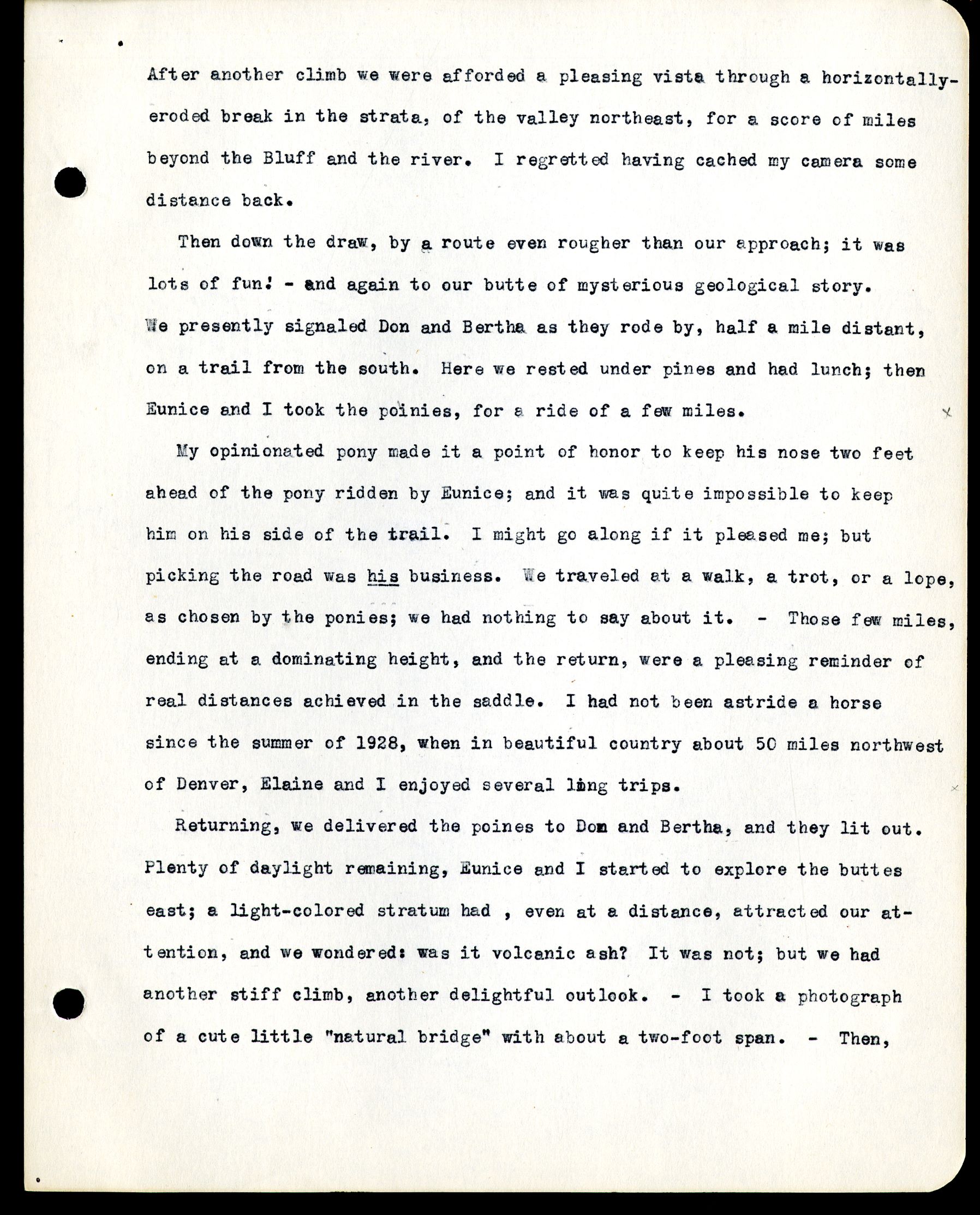
After another climb we were afforded a pleasing vista through a horizontally-eroded break in the strata, of the valley northeast, for a score of miles beyond the Bluff and the river. I regretted having cached my camera some distance back.
Then down the draw, by a route even rougher than our approach; it was lots of fun! – and again to our butte of mysterious geological story. We presently signaled Don and Bertha as they rode by, half a mile distant, on a trail form the south. Here we rested under pines and had lunch; then Eunice and I took the poinies, for a ride a few miles.
My opinionated pony made it a point of honor to keep his nose two feet ahead of the pony ridden by Eunice; and it was quite impossible to keep him on his side of the trail. I might go along it if pleased me; but picking the road was his business. We traveled at a walk, a trot, or a lope, as chosen by the ponies; we had nothing to say about it. – Those few miles, ending at a dominating height, and the return, were a pleasing reminder of real distances achieved in the saddle. I had not been astride a horse since the summer of 1928m when in beautiful country about 50 miles northwest of Denver, Elaine and I enjoyed several long trips.
Returning, we delivered the poines to Don and Bertha, and they lit out. Plenty of daylight remaining, Eunice and I started to explore the buttes east; a light-colored stratum had , even at a distance, attracted our attention, and we wondered: was it volcanic ash? It was no; but we had another stiff climb, another delightful outlook. – I took a photograph of a cute little “natural bridge: with about a two-foot span. – Then,

Descending, we characteristically selected a hard way, where team work was needful now and then.
Eunice is always ready for an expedition. With a lovely curiosity about things, unbounded enthusiasm, tireless to the day’s end, interested in every phase of nature and knowing a heap about it, and with the rare temperamental gift of accepting passing misadventure with a smile ,she is one grand companion.
We left Selby’s ranch a few shades after dark.
June 8 As I stepped out a few minutes ago, at 9 p m, my feet crunched in ice – on June 8th!
I had planned to go to Scottsbluff at 5 p m, but at that hour a heavy cloud moved northeastward, with a strong wind. – At 5:30 a hail-storm arrived, sweeping from north to south or southeast, large stones hitting the pavement and dashing to pieces; then smaller stones, but a billion of them. Across the street (I was dining in the Welcome Inn, west side of Tenth) I could see, during the fall of the heavy stones, the windows in National Parks, McGriff’s, and the Courier office, smash one by one; and the street was white with hail, banked more than a foot deep against the west-facing building. – Then, suddenly, it was over; humans came from cover to appraise the damage. And sheets of heavy paper, reinforced with strips of lumber, were spread over the breaks…
Noting which, the sky gods bust forth again! another hail-storm, with bigger stones and a stronger wind! Soon the street was whiter than ever,
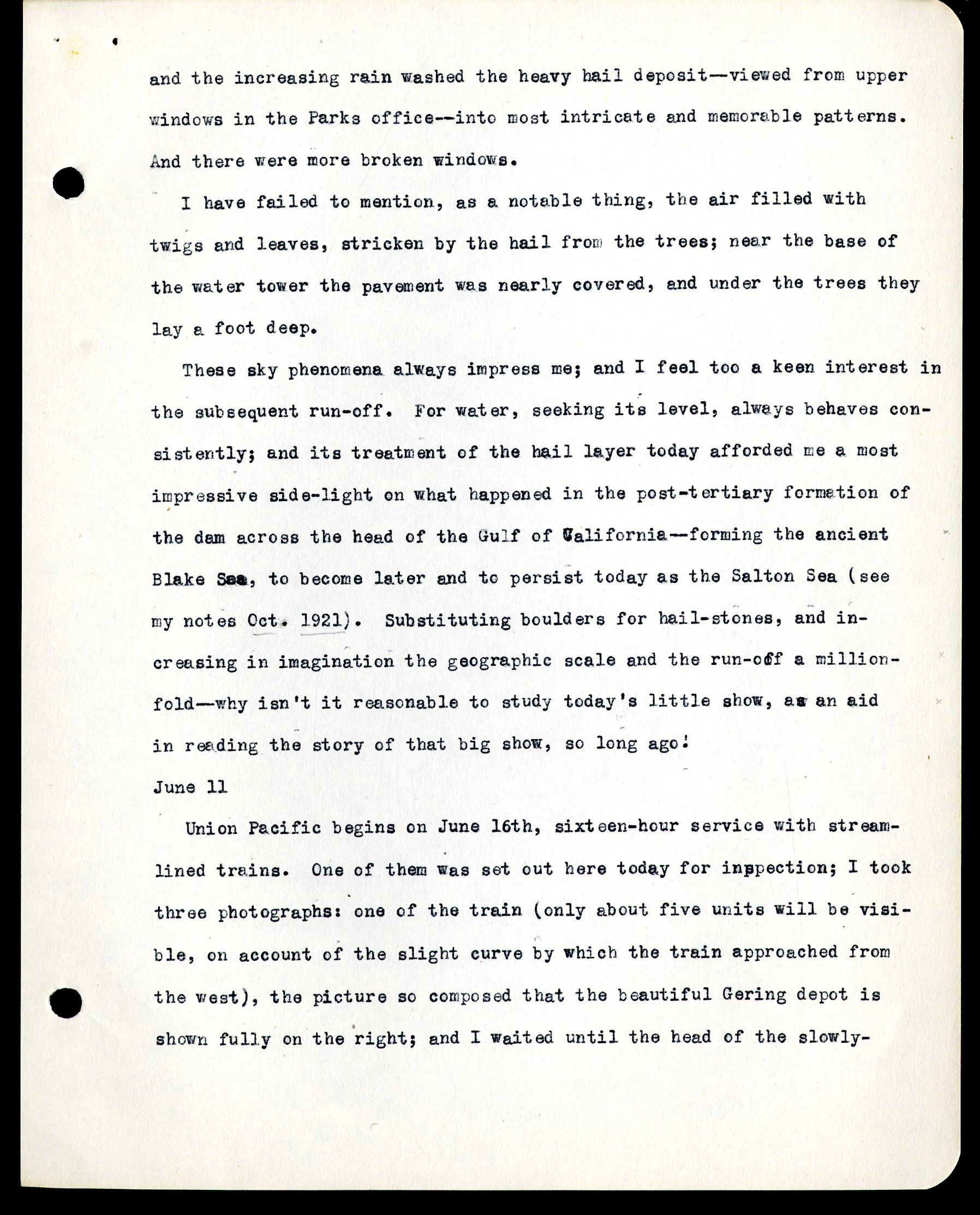
and the increasing rain washed the heavy hail deposit-viewed from upper windows in the Parks office-into most intraicate and memorable patters. And there were more broken windows.
I have failed to mention, as a notable thing, the air filled with twigs and leaves, stricken by the hail form the trees; near the base of the water tower the pavement was nearly covered, and under the trees they lay a foot deep.
These sky pehnomena always impress me; and I feel too a keen interest in the subsequent run-off. For water, seeking its level, always behaves consistently; and its treatment of the hail layer today afforded me a most impressive side-light on what happened in the post-tortiary formation of the dam across the head of the Gulf of California – forming the ancient Blake Sea, to become later and to persist toady as the Salton Sea (see my notes Oct. 1921). Substituting boulders for hail-stones, and increasing in imagination the geographic scale and the run-off a million-fold – why isn’t it reasonable to study today’s little show, aw an aid in reading the story of that bid show, so long ago!
June 11 Union Pacific begins on June 16th, sixteen-hour service with streamlined trains. One of them was set out here today for inspection; I took three photographs: one of the train (only about five units will be visible, on account of the slight curve by which the train approached form the west), the picture so composed that the beautiful Gering depot is shown fully on the right; and I waited until the head of the slowly-

approaching train was within a few feet of the building (behind which it would pass) before I made the exposure. – Another picture, to the northeast, showing the station and a part of the train. – Another, from the platform for freight unloading, showing the head of the train and a few cars. – The local constable, friend of mine, pulled a good one while I was taking this last picture – on forbidden ground: “You needn’t hide under that focussin’ cloth; we seen you when you come in!”
Later in the day I went through the train – a marvel of convenience and efficiency. How silly it will make appear the old-time statistical sheet “Tons per Passenger per Mile”; formerly it was not uncommon to roll two tons or more of carriage facility for each passenger.
On my return I took what I hope will prove to be a pleasing photo of the court house: an oblique across its pillared front, in perpendicular panel.
June 16 Five photographs: depot; Gering Hotel; three of beet-sugar factory.
June 18 A pleasant hour in the evening with Mrs. (don’t remember’ she is our Gering finisher of amateur photos); took with me fifty prints or so. She is desirous of getting some pointers about the use of transparent colors; and we have arranged for an evening with slides sometime soon.
Have data; notes not completed
June 23, 1936
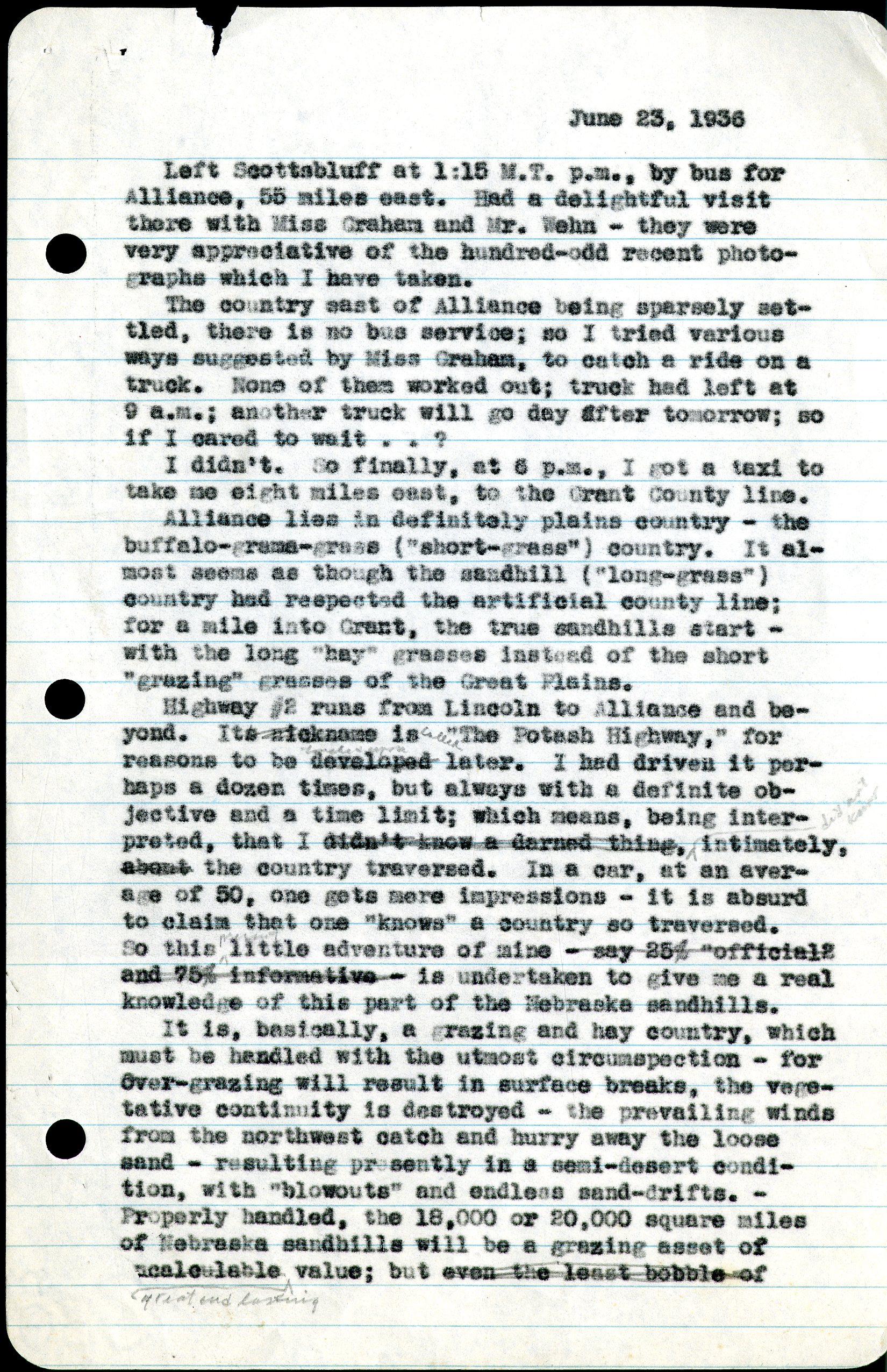
June 23, 1936
Left Scottsbluff at 1:15 M.T. p.m., by bus for Alliance, 55 miles east. Had a delightful visit there with Miss Graham and Mr. When – they were very appreciative of the hundred-odd recent photographs which I have taken.
The country east of Alliance being sparsely settled, there is no bus service; no I tried various ways suggested by Miss Graham, to catch a ride on a truck. None of them worked out; truck had left at 9 a.m.; another truck will go day after tomorrow; so if I cared to wait . . ?
I didn’t. So finally, at 6 p.m., I got a taxi to take me eight miles east, to the Grant County line.
Alliance lies in definitely plains country – the buffalo-grams-grass (“short-grass”) country. It almost seems as though the sandhill “long-grass”) country had respected the artificial county line; for a mile into Grant, the true sandhillls starting with the long “hay” grasses instead of the short “grazing” grasses of the Great Plains.
Highway #2 runs from Lincoln to Alliance and beyond. Its nickname is “The Potash Highway,” for reasons to be developed later. I had driven it perhaps a dozen times, but always with a definite objective and a time limit; which means, being interpreted, that I didn’t know a darned thing, intimately, about the country traversed. In a car, at an average of 50, one gets mere impressions – it is absurd to claim that one “knows” a country so traversed. So this little adventure of mine – say 25% “official” and 75% information – is undertaken to give me a real knowledge of this part of the Nebraska sandhills.
It is, basically, a grazing and hay country, which must be handled with the utmost circumspection – for over-grazing will result in surface breaks, the vegetative community is destroyed – the prevailing winds from the northeast catch and hurry away the loose sand – resulting presently in a semi-desert condition, with “blowouts” and endless sand-drifts. – Properly handled, the 18,000 or 20,000 square miles of Nebraska sandhills will be a grazing asset of incalculable value; but even the least bobble of
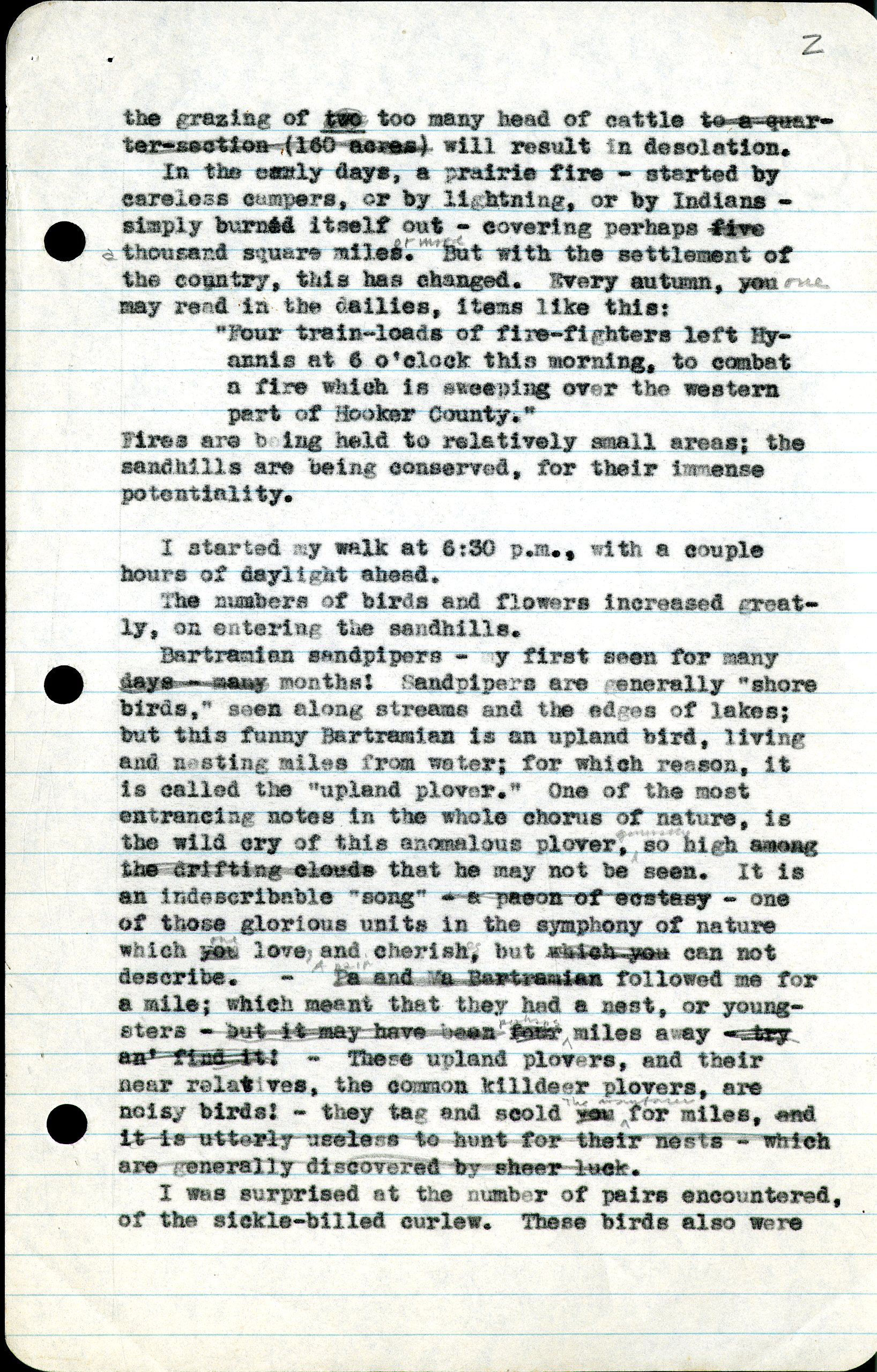
the grazing of two too many head of cattle to a quarter-section (160 acres) will result in desolation.
In the early days, a prairie fire – started by careless campers, or by lightning, or by Indians – simply burned itself out – covering perhaps five thousand square miles. But with the settlement of the country, this has changed. Every autumn, you may read in the dailies, items like this: “Four train-loads of fire-fighters left Hyannis at 6 o’clock this morning, to combat a fire which is sweeping over the western part of Hooker County.” Fires are being held to relatively small areas; the sandhills are being conserved, for their immense potentiality.
I started my walk at 6:30 p.m., with a couple hours of daylight ahead.
The numbers of birds and flowers increased greatly, on entering the sandhills.
Bartreamian sandpipers – my first seen for many days – many months! Sandpipers are generally
“shore birds,” seen along streams and the edges of lakes; but this funny Bartramian is an upland bird, living and nesting miles from water; for which reason, it is called the “upland plover.” One of the most entrancing notes in the whole chorus of nature, is the wild cry of this anomalous plover, so high among the drifting clouds that he may not be seen. It is an indescribable “song” – a paeon of ecstasy – one of those glorious units in the symphony of nature which you love and cherish, but which you can not describe. – Pa and Ma Bartramian followed me for a mile; which meant that they had a nest, or youngsters – but it may have been four miles away – try an’ find it! – These upland plovers, and their near relatives, the common killdeer plovers, are noisy birds! – they tag and scold you for miles, and it is utterly useless to hunt for their nests – which are generally discovered by sheer luck.
I was surprised at the number of pairs encountered, of the sickle-billed curlew. These birds also
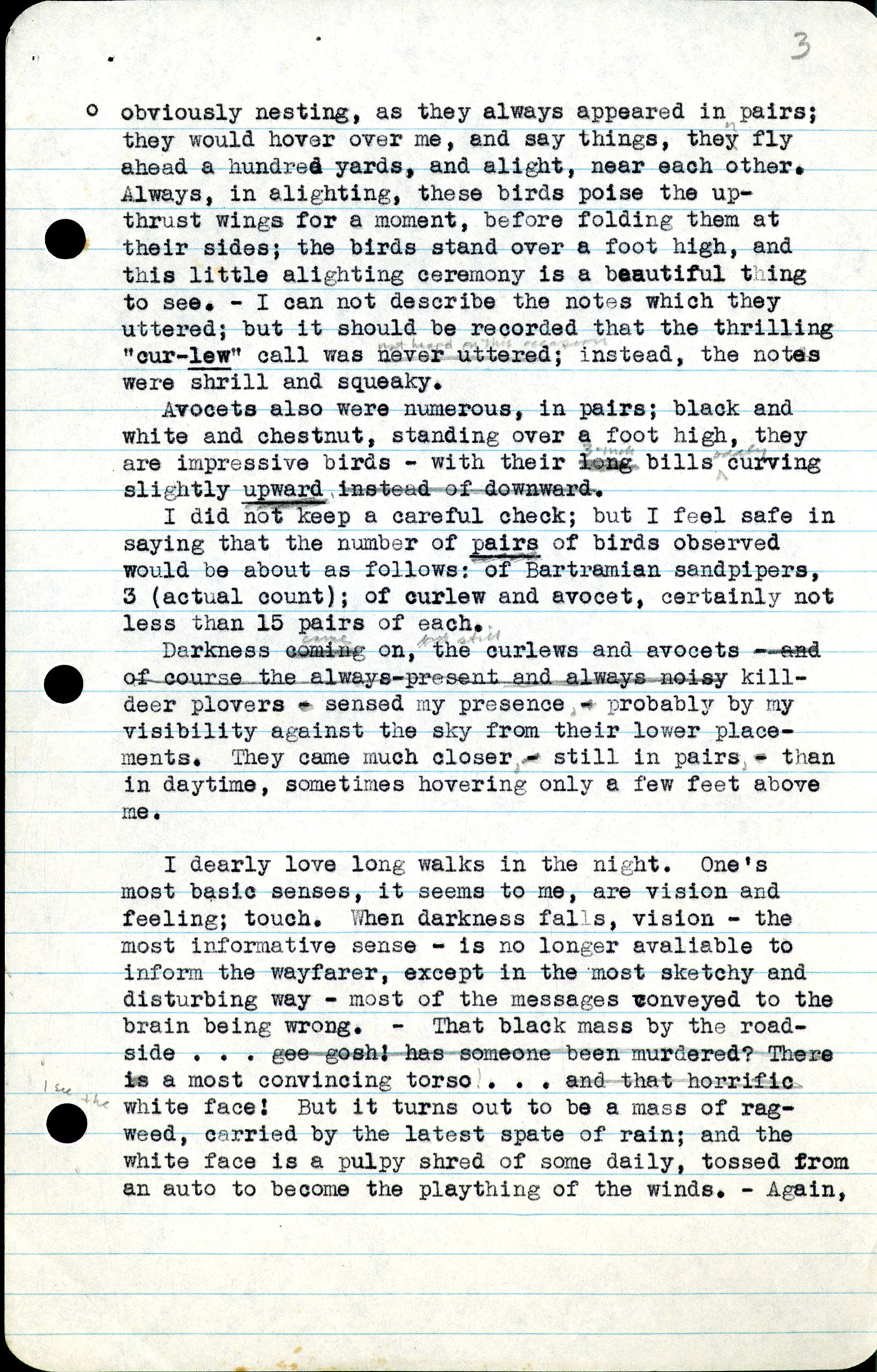
obviously nesting, as they always appeared in pairs; they would hover over me, and say things, then fly ahead a hundred yards, and alight, near each other. Always, in alighting, these birds poise the upthrust wings for a moment, before folding them at their sides; the birds stand over a foot high, and this little alighting ceremony is a beautiful thing to see. – I can not describe the notes which they uttered; but it should be recorded that the thrilling “cur-lew” call was never uttered; instead, the notes were shrill and squeaky.
Avocets were also numerous, in pairs; black and white and chestnut, standing over a foot high, they are impressive birds – with their long bills curving slightly upward instead of downward.
I did not keep a careful check; but I feel safe in saying that the number of pairs of birds observed would be about as follows: of Bartramian sandpipers, 3 (actual count); of curlew and avocet, certainly not less than 15 pairs of each.
Darkness coming on, the curlews and avocets – and of course the always-present and always noisy killdeer plovers – sensed my presence – probably by my visibility against the sky from their lower placements. They came much closer – still in pairs – than in daytime, sometimes hovering only a few feet above me.
I dearly love long walks in the night. One’s most basic senses, it seems to me, are vision and feeling; touch. When darkness falls, vision – the most informative sense – is no longer available to inform the wayfarer, except in the most sketchy and disturbing way – most of the messages conveyed to the brain being wrong. – The black mass by the road-side . . . gee gosh! has someone been murdered? There is a most convincing torso . . . and that horrific white face!But it turns out to be a mass of ragweed, carried by the latest spate of rain; and the white face is a pulpy shred of some daily, tossed from an auto to become the plaything of the winds. – Again,
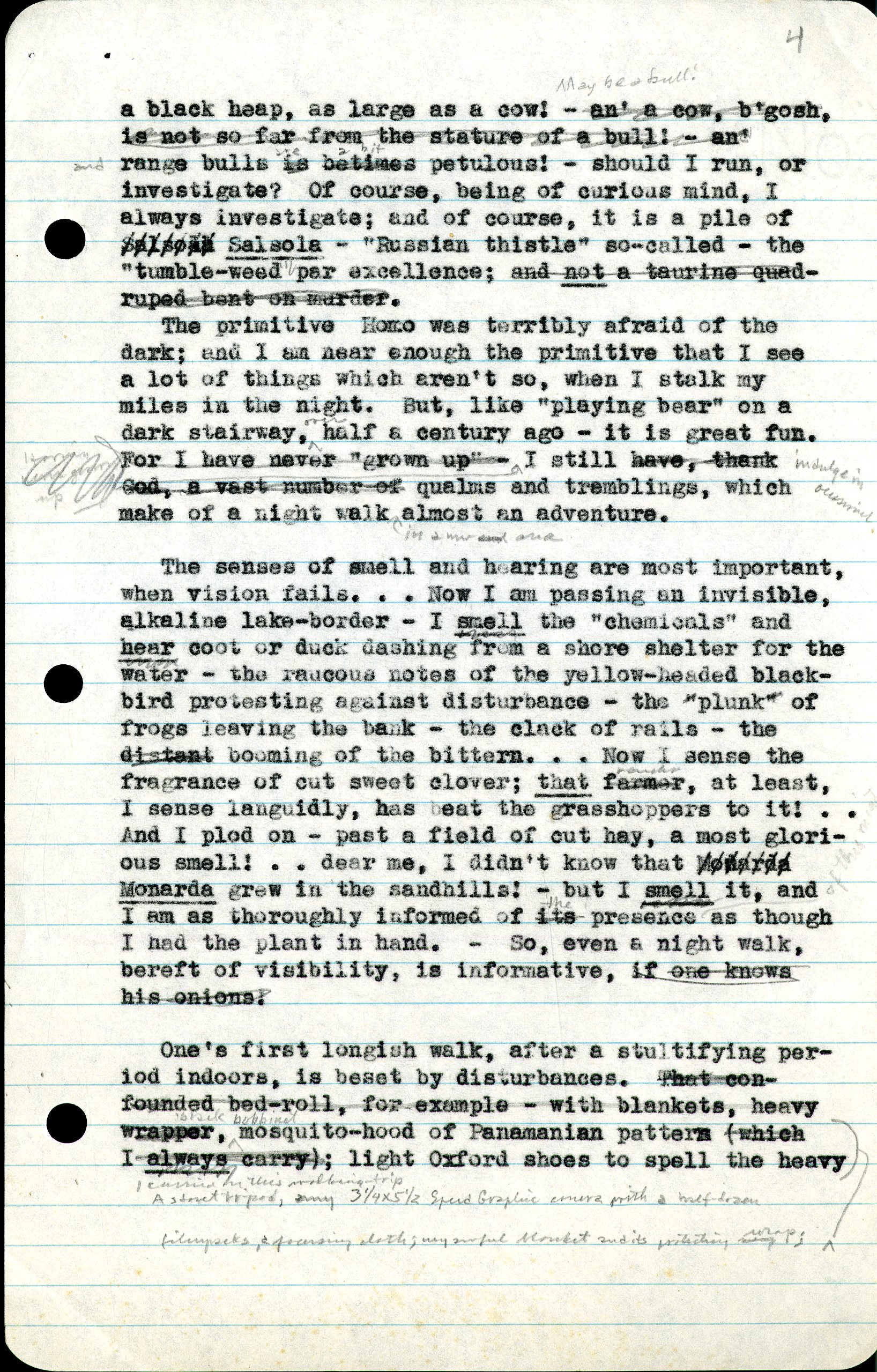
a black heap, as large as a cow! – an’ a cow, b’gosh, is not so far from the stature of a bull! – an’ range bulls is betimes patulous! – should I run, or investigate? Of course, being of curious mind, I always investigate; and of course, it is a pile of Salsola – “Russian thistle” so-called – the “tumblr-weed” par excellence; and not a taurine quadruped bent on murder.
The primitive Homo was terribly afraid of the dark; and I am near enough the primitive that I see a lot of things which aren’t so, when I stalk my miles in the night. But, like “playing bear” on a dark stairway, half a century ago – it is great fun. For I have never “grown up” – I still have, thank God, a vast number of qualms and tremblings, which make of a night walk almost an adventure.
The senses of smell and hearing are most important, when vision fails . . . Now I am passing an invisible, alkaline lake-border – I smell the “chemicals” and hear coot or duck dashing from a shore shelter for the water – the raucous notes of the yellow-headed blackbird protesting against disturbance – the “plunk” of frogs leaving the bank – the clack of rails – the fragrance of cut sweet clover; that farmer, at least, I sense languidly, has beat the grasshoppers to it! . . And I plod on – past a field of guy hay, a most glorious smell! . . dear me, I didn’t know that Monarda grew in the sandhills! – but I smell it, and I am as thoroughly informed of its presence as though I had the plant in hand. – So, even a night walk, bereft of visibility, is informative, if one knows his onions.
One’s first longish walk, after a stultifying period indoors, is beset by disturbances. That confounded bed-roll, for example – with blankets, heavy wrapper, mosquito-hood of Panamanian pattern (which I always carry); light Oxford shoes to spell the heavy
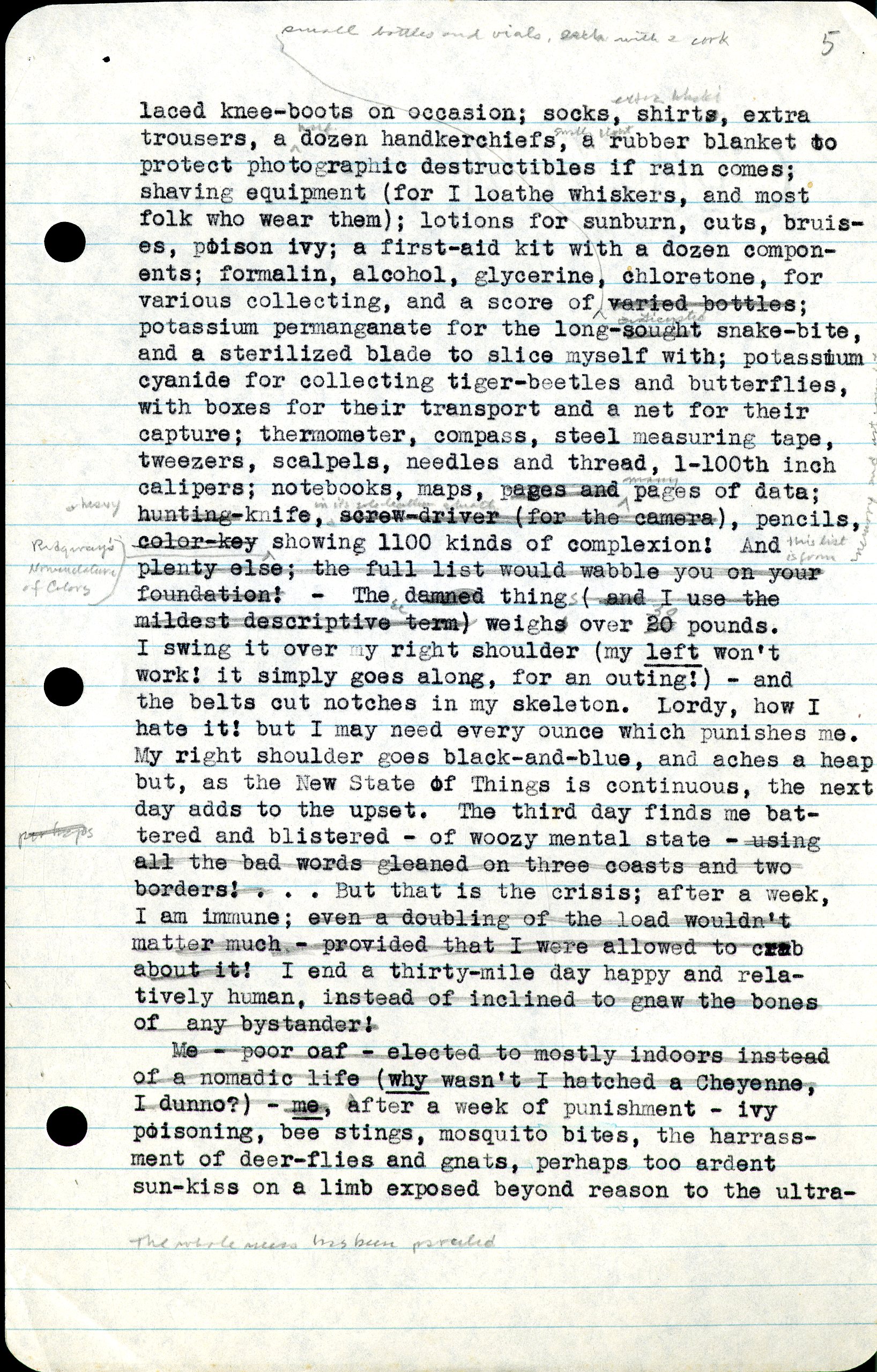
laced knee-boots on occasion; socks, shirts, extra trousers, a dozen handkerchiefs, a rubber blanket to protect photographic destructibles if rain comes; shaving equipment (for I loathe whiskers, and most folk who wear them); lotions for sunburn, cuts, bruises, poison ivy; a first-aid kit with a dozen components; formalin, alcohol, glycerine, chloretone, for various collecting, and a score of varied bottles; potassium permanganate for the long-sought snake-bite, and a sterilized blade to slice myself with; potassium cyanide for collecting tiger-beetles and butterflies, with boxes for their transport and a net for their capture; thermometer, compass, steel measuring tape, tweezers, scalpels, needles and thread, 1-100th inch calipers; notebooks, maps, pages and pages of data; hunting knife, screw driver (for the camera), pencils, color-key showing 1100 kinds of complexion! And plenty else; the full list would wabble you on your foundation! – The damned things (and I use the mildest descriptive term) weighs over 20 30 pounds. I swing it over my right shoulder (my left won’t work! it simply goes along, for an outing!) – and the belts cut notches in my skeleton. Lordy, how I hate it! But I may need every ounce which punishes me. My right shoulder goes black-and-blue, and aches a heap but, as the New State of Things is continuous, the next day adds to the upset. The third day finds me battered and blistered – of woozy mental state – using all the bad words gleaned on three coasts and two borders! . . . But that is the crisis; after a week, I am immune; even a doubling of the load wouldn’t matter much – provided that I were allowed to crab about it! I end a thirty-mile day happy and relatively human, instead of inclined to gnaw the bones of any bystander!
Me – poor oaf – elected to mostly indoors instead of a nomadic life (why wasn’t I hatched a Cheyenne, I dunno?) – me, after a week of punishment – ivy poisoning, bee stings, mosquito bites, the harassment of deer-flies and gnats, perhaps too ardent sun-kiss on a limb exposed beyond reason to the ultra-
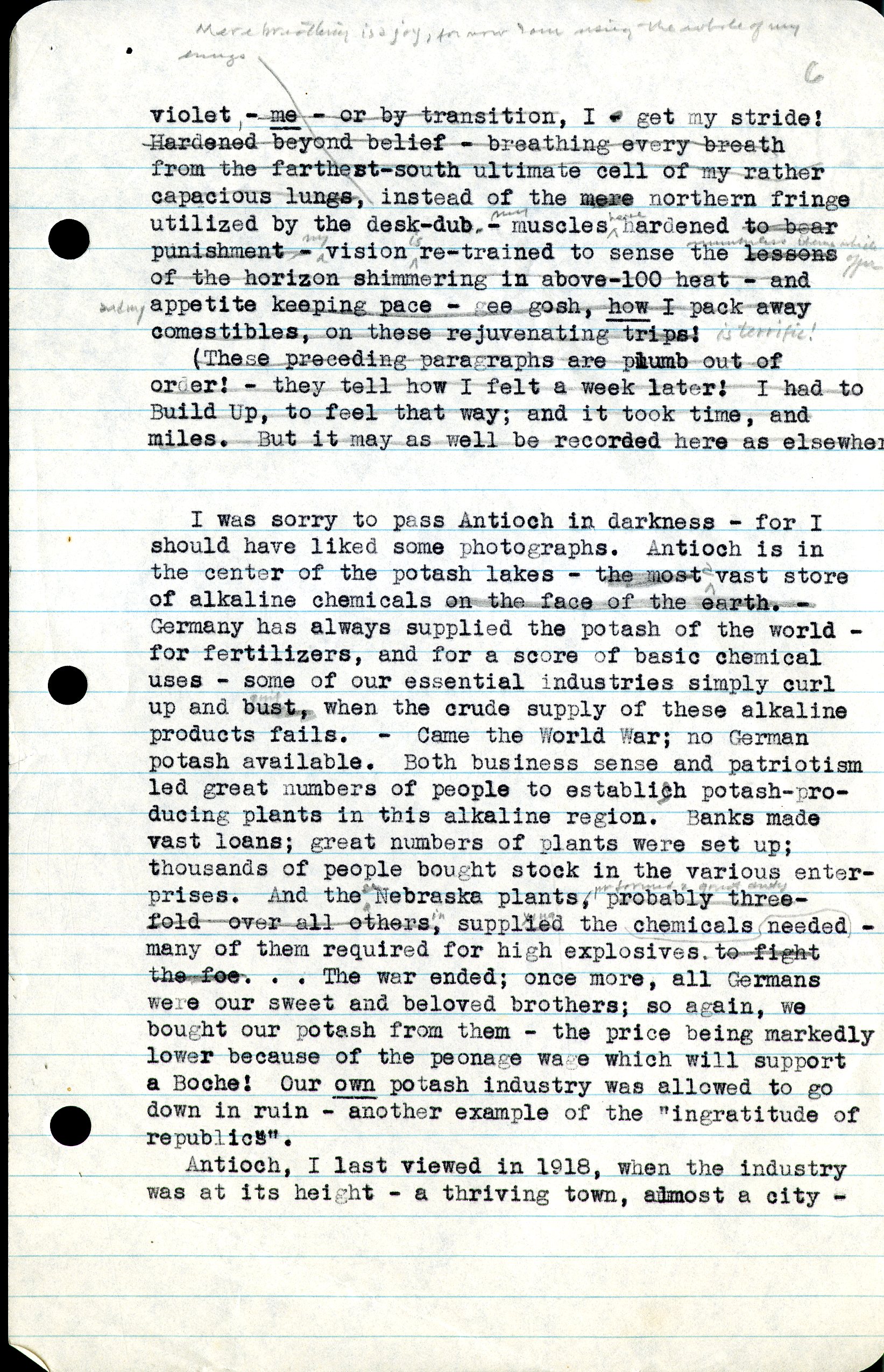
violet – me – or by transmission, I – get my stride! Hardened beyond belief – breathing every breath from the farthest-south ultimate cell of my rather capacious lungs, instead of the mere northern fringe utilized by the desk-dub – muscles hardened to bear punishment –vision re-trained to sense the lessons of the horizon shimmering in above-100 heat – and appetite keeping pace – gee gosh, how I pack away comestibles, on these rejuvenating trips!
(The preceding paragraphs are plumb out of order! – they tell how I felt a week later! I had to Build Up, to feel that way; and it took time, and miles. But it may as well be recorded here as elsewhere.)
I was sorry to pass Antioch in darkness – for I should have liked some photographs. Antiock is in the center of the potash lakes – the most vast store of alkaline chemicals on the face of the earth. – Germany has always supplied the potash of the world – for fertilizers, and for a score of basic chemical uses – some of our essential industries simply curl up and bust, when the crude supply of these alkaline products fails. – Came the World War; no Gernman potash available. Both business sense and patriotism left great numbers of plants were set up; thousands of people bought stock in the various enterprises. And the Nebraska plants, probably three-fold over all others, supplied the chemicals needed – many of them required for high explosives to fight the foe . . . The war ended; once more, all Germans were our sweet and beloved brothers; so again, we bought our potash from them – the price being markedly lower because of the peonage wage which will support a Boche! Our own potash industry was allowed to go down in ruin – another example of the “ingratitude of republics.”
Antioch, I last viewed in 1918, when the industry was at its height – a thriving town, almost a city –

with thousands of workmen, fine commercial houses, the streets crowded; a bee-hive of industry. But now . .
The Antioch of my night walk, by the light of a quarter-past moon and every star in the heavens, was a matter of silhouettes. For two miles along the “Potash Highway” I could see, to the north, plant after plant – huge buildings – great banks of boilers and tanks; dark masses of ruin, spelling disaster running into many millions of dollars. Not one enterprise operating – complete devastation – because Germany is our beloved and trusted friend – and furnishes cheaper potash!
There is a railroad station; a post office; a store or two; scores of dark masses representing abandoned ventures; the glow, here and there, of a kerosene lamp in some humble home – for there is not “city” electric lighting system. It is simply a city done to death – because subsidized German potash costs less! “The ingratitude of republics!”